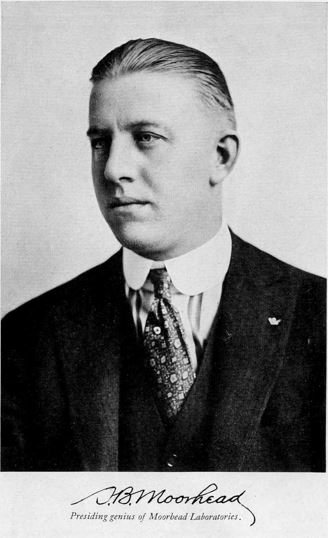
While this article is a re-do of a previous work, it has never appeared in either the old TCA magazine or on this website. It is not the complete line Otis Moorhead offered, but it represents a good deal of his product line. All tubes reside in the Joe Gruber collection.
Click on the pictures below to enlarge and hyperlinks to view.
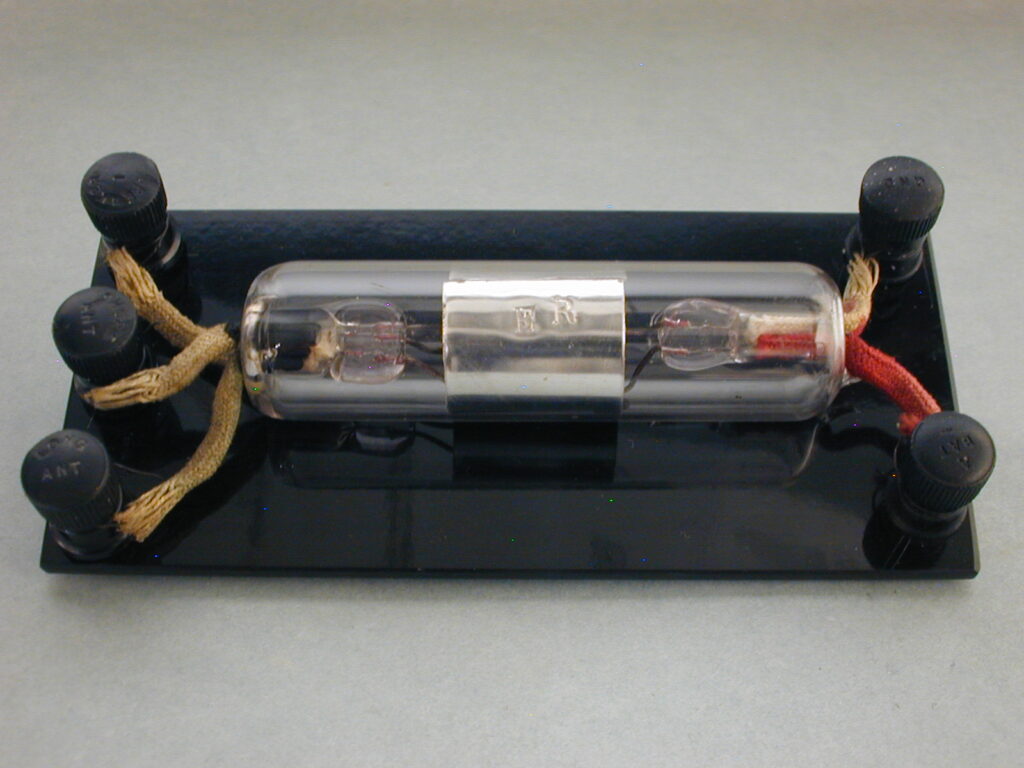
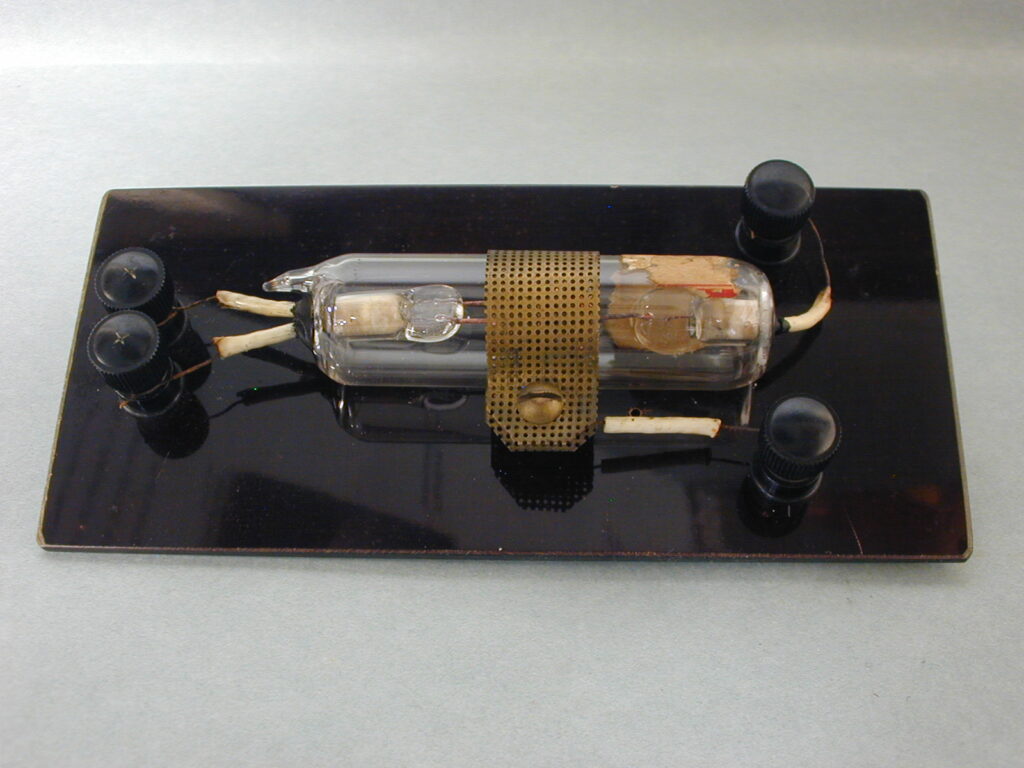
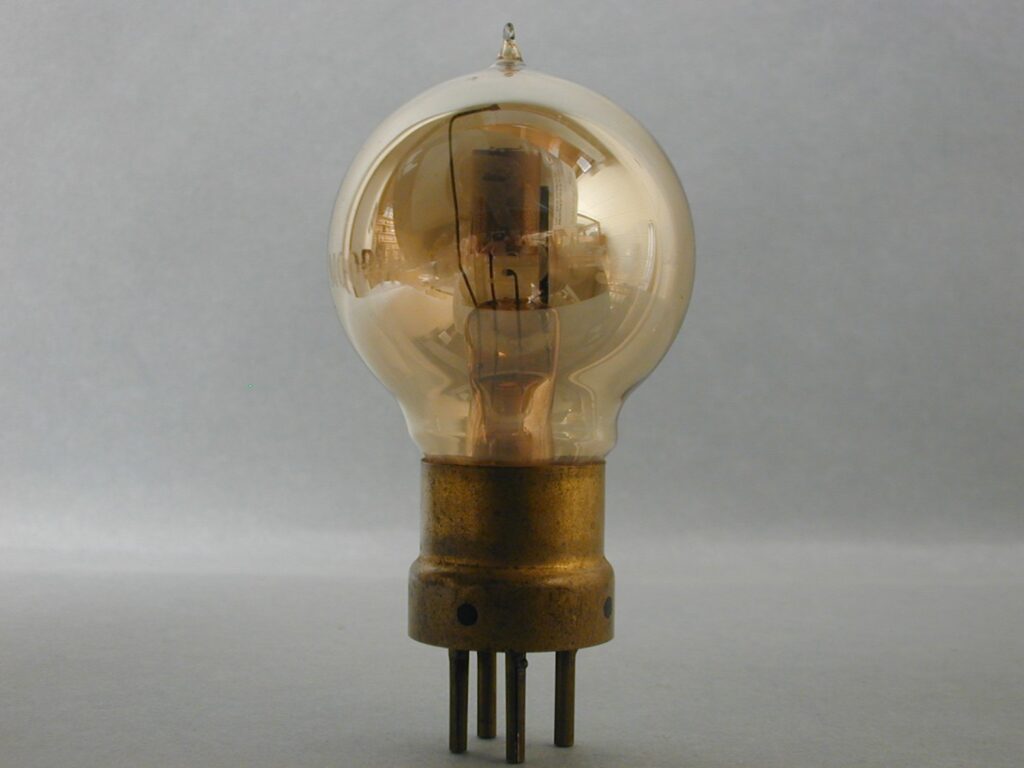
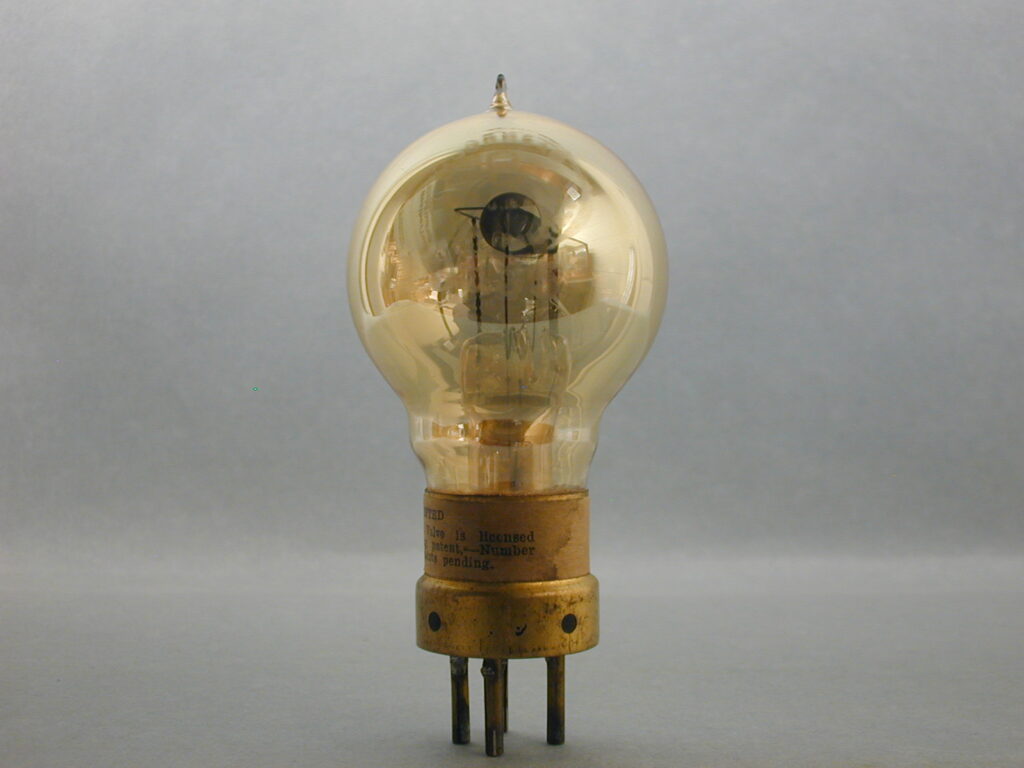
Fig. 1. Moorhead Laboratories Inc. produced this tubular Electron Relay tube starting in 1915 in several different forms until well after the US entered World War 1. It can be difficult to determine who made examples of these types of tubular vacuum tubes but there are a few clues to keep in mind to help. The press in the pictured example is fatter than long and narrow as have been observed in Cunningham Audiotron’s, for example. DeForest tubular Audion presses have a shape that can be a combination of each the Moorhead and Cunningham tubes. The insulation on the DeForest examples are usually rubber rather than cloth. The Moorhead example above has an ER stamped on the plate which makes an ID easy but this type of stamping is not consistent. This tube has a double filament but they were made with a single filament as well. Quite rare in that version. Moorhead wrote a paper that appeared in the IRE. Click here to read the original: MIRE B.F. McNamee wrote an article about his early days with Moorhead. Double click to read here: BFM Moorhead wrrote an article regarding his Electron Relay that appeared in the Pacific Radio News that can be read here: PR_N Moorhead also wrote an article on the DeForest litigation brought against him here: MVD Moorhead also sold 2 control boxes for his tubular Electron Relay tubes with a panels in Feb., 1917 and started the sales from his office and factory on 165 Jesse St. San Francisco. See his 2 bulletins and an ad here: M_B_A
Fig. 2. Moorhead Labs made and started to advertise the external grid Electron Relay, as a replacement for the internal grid E.R. in Fig 1 in 1916 in response to grid patent infringement threats from DeForest. Also, rejections from national magazines for ads he wanted to place ads in became a problem as well. While the threats stopped, tube sales dropped because the external grid E.R. simply did not work. The example above has a short, small loop single filament with the 2 leads for same emanating from one end, a 3rd single plate lead out the other end for the plate with Moorhead and patent pending stamped on it, and of course the brass grid on the outside of the glass bulb held on with a bolt and nut as the 4th lead.
Fig. 3. The US government, knowing full well that it would enter the WW1 conflict in Europe, cancelled all patent litigation cases so anyone could submit vacuum tubes designs for possible use. This fact did not escape Moorhead, who started designing the R receiving valve for the British who could not meet their needs. As can be seen, it has the British standard base to fit into their radios. He made the R valve in large quantities and shipped them to Britian. Moorhead, with the help of his chief engineer, E.C. Lange, wrote an article that appeared in the IRE in 1919 but it appeared with the information regarding the type R and generally about all Moorhead tubes. Click to read it here: M_L19
Fig.4. Moorhead also made a transmitting valve called the B. Again, these were made with the British standard base and shipped out. About the time Moorhead was making and shipping war time tubes, a very curious Pacific Labs sales sheet probably made in 1918, mentions 4 tubes sent to the US and British Governments- the relay, probably very similar to the early tubular Electron Relay, the type R for reception, unbased, the type RH- as an amplifier and oscillator- no picture, and the type B for transmitting-no picture shown. Click on the hyperlink to view the sales sheet and what this author thinks is a based type R in his collection. What I think is a type R in my collection is factory based in a Shaw standard socket with the Marconi/DeForest logos pressed into the base, and it has an odd pressed glass system to hold the plate steady but looks much like the ad. Click to view it here: SDR
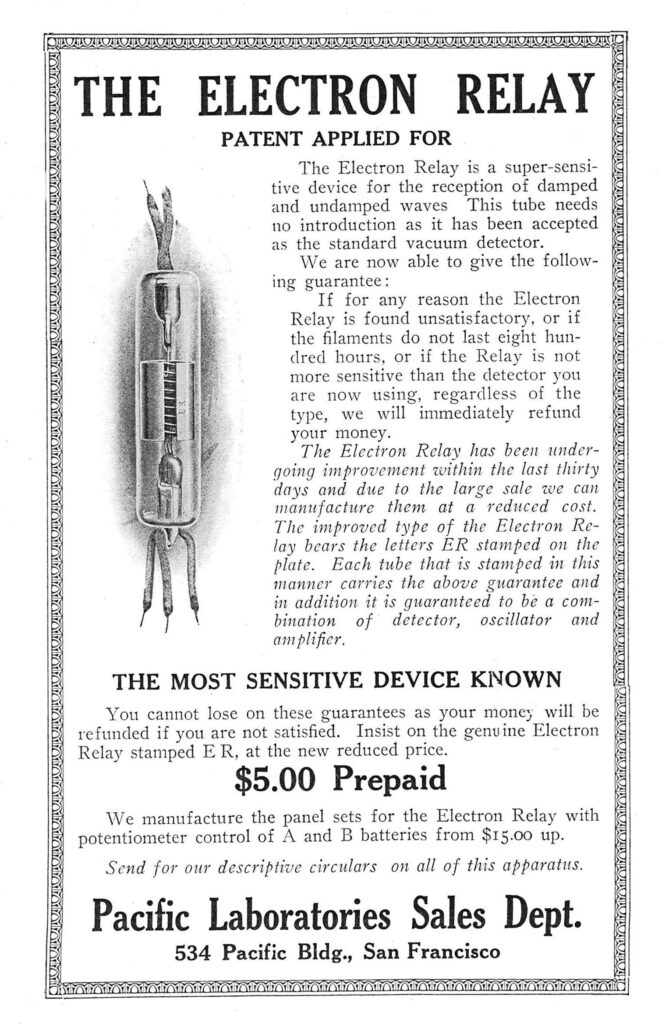
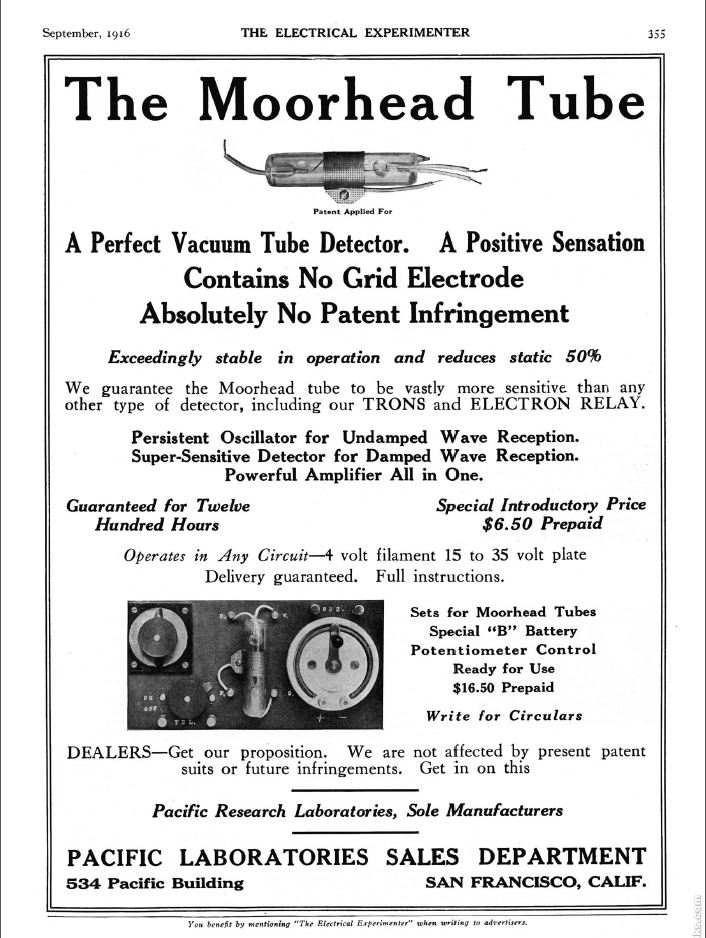
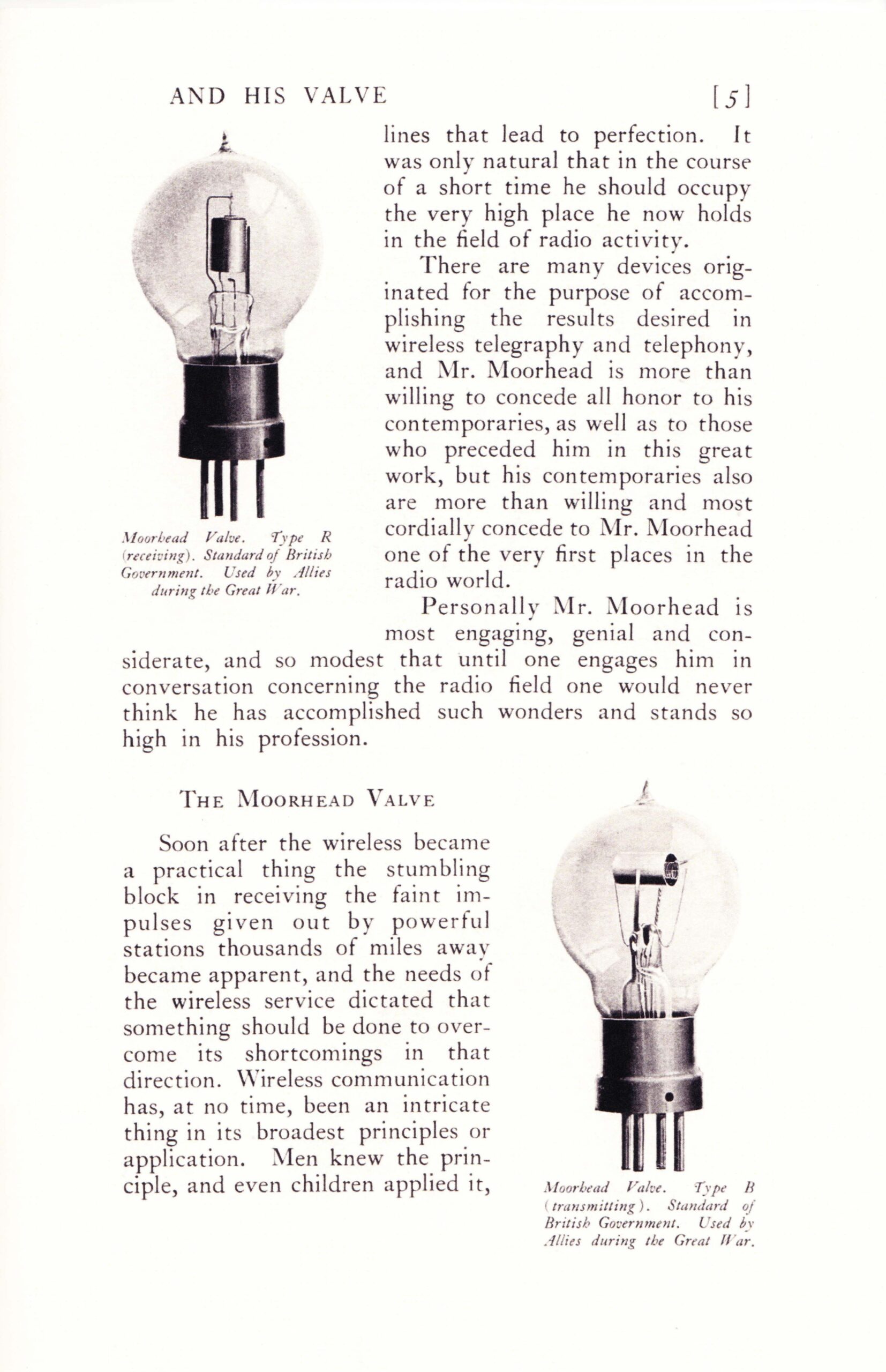
Figs. 5, 6 are ads for the Electron Relay and the external grid E.R. respectively. Fig. 7 shows the Moorhead type R and B from the catalog “Moorhead and His Valve”.
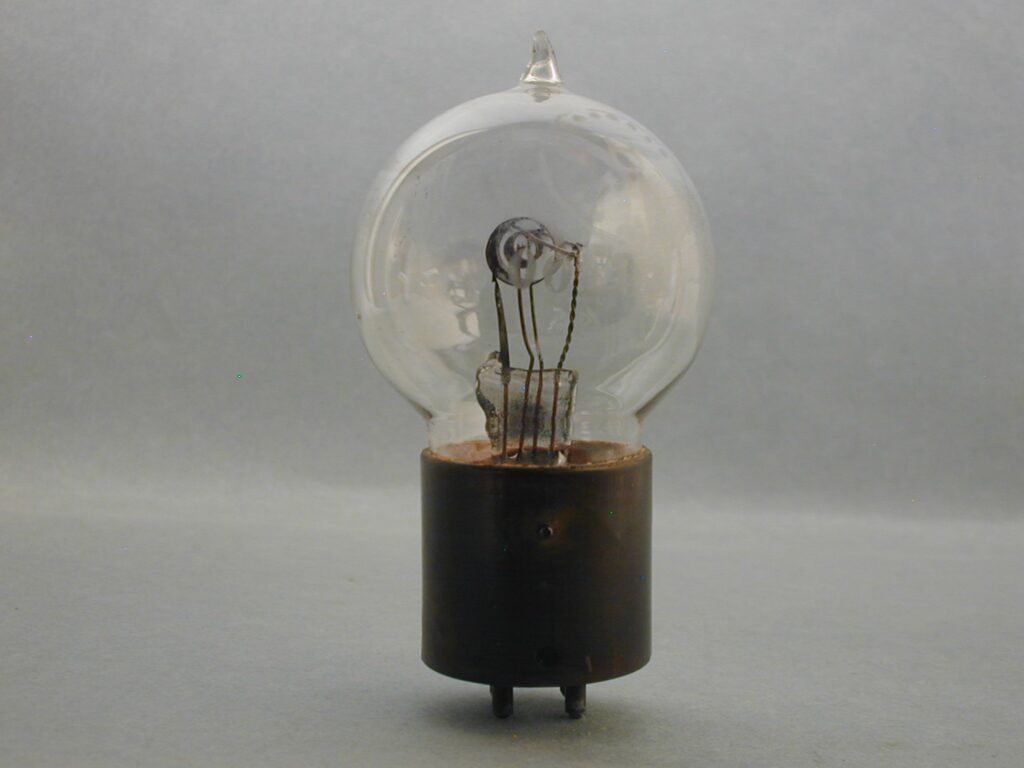
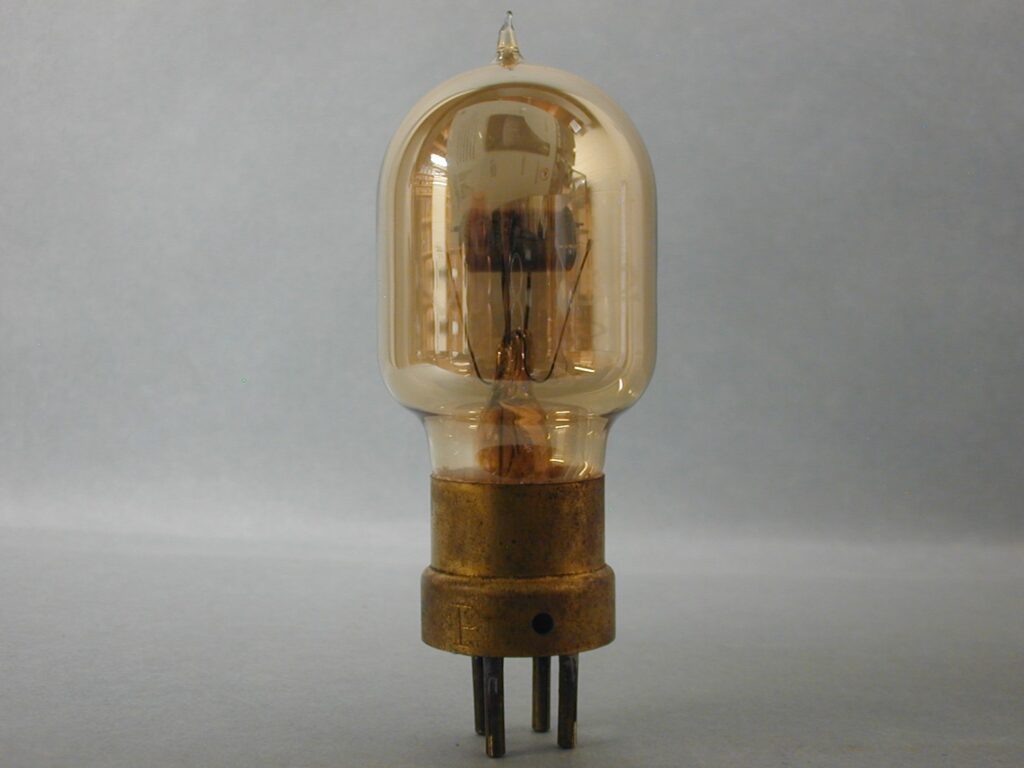
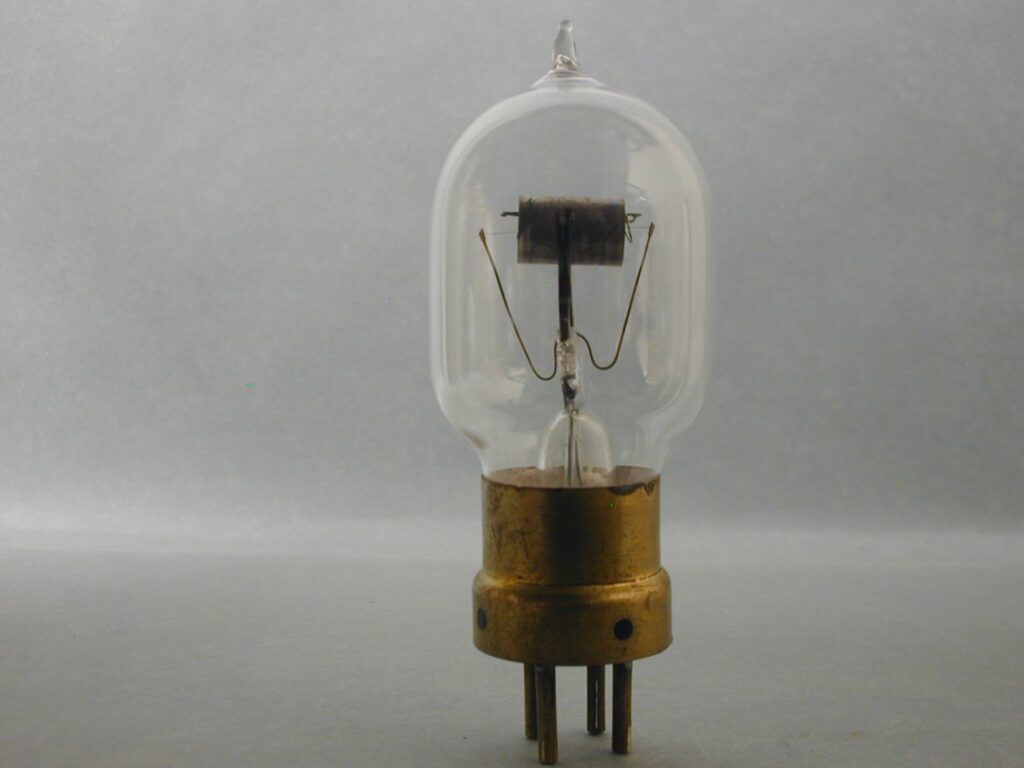
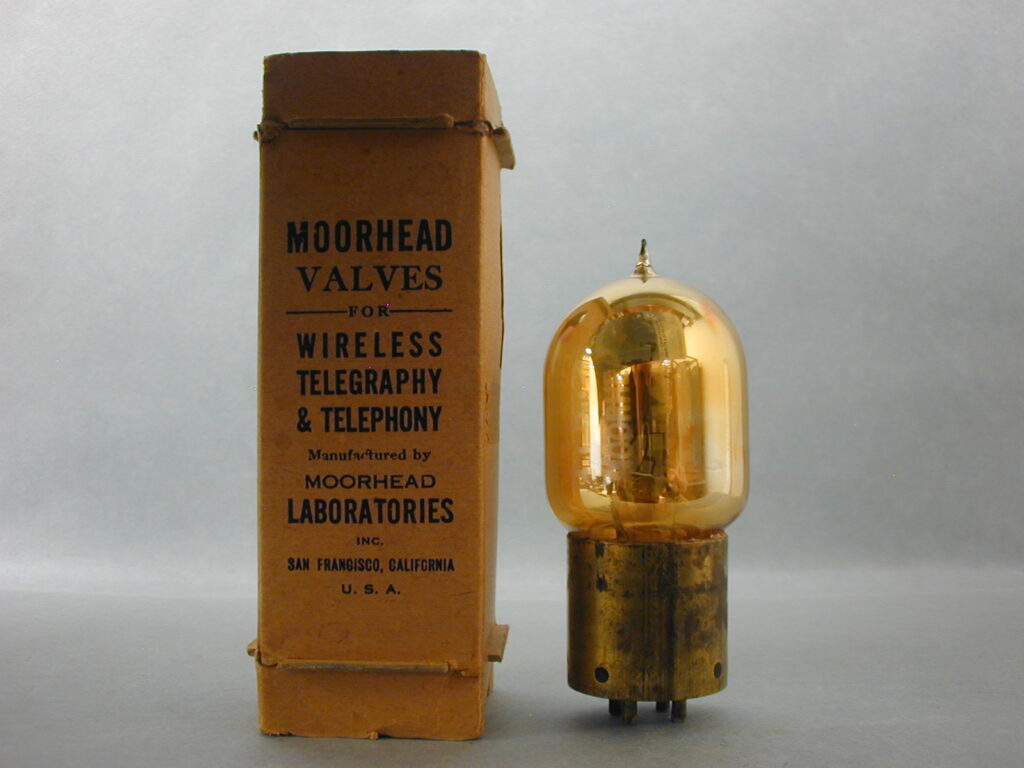
Fig. 8. Moorhead type B transmitting tube with a US standard Shaw base- US version of the valve in fig. 4. This author previously thought that this must be an experimental version of the British type B valve with a US base for ease of testing and it very well could be, however, after seeing at least 2 other tubes of this type, they could have been made to be sold in the US. Picture of Moorhead over seeing his factory in 1918 here: P_OM
Fig. 9. Moorhead type VT-32 transmitting valve with a British standard base and phosphorus getter. This valve was to replace the Moorhead type B valve shown in figure 4, but WW! ended before they could be shipped to Britian. They are available in the US but it could be speculated that they are quite rare in Britian. Moorhead applied for a patent and received same on the a micro welding process seen here: M_P
Fig. 10. Same valve as fig. 9 but without the phosphorus getter. There are many less of this clear version.
Fig. 11. The WW1 tube Moorhead SE 1444 was used extensively by the US Navy. This was the only tube used by the US military that could be used as a receiver and transmitter. Some SE-1444’s had a phosphorus getter, as this one does, or they were made with a clear bulb. It was also used on the first crossing of the Atlantic in 1919 for which Moorhead received an award. Frank Polkinghorn wrote an letter explaining his memory on the Moorhead Laboratories Inc. in the early days with Moorhead. The Moorhead Se 1444 was one such subject. Read it here: FP_P
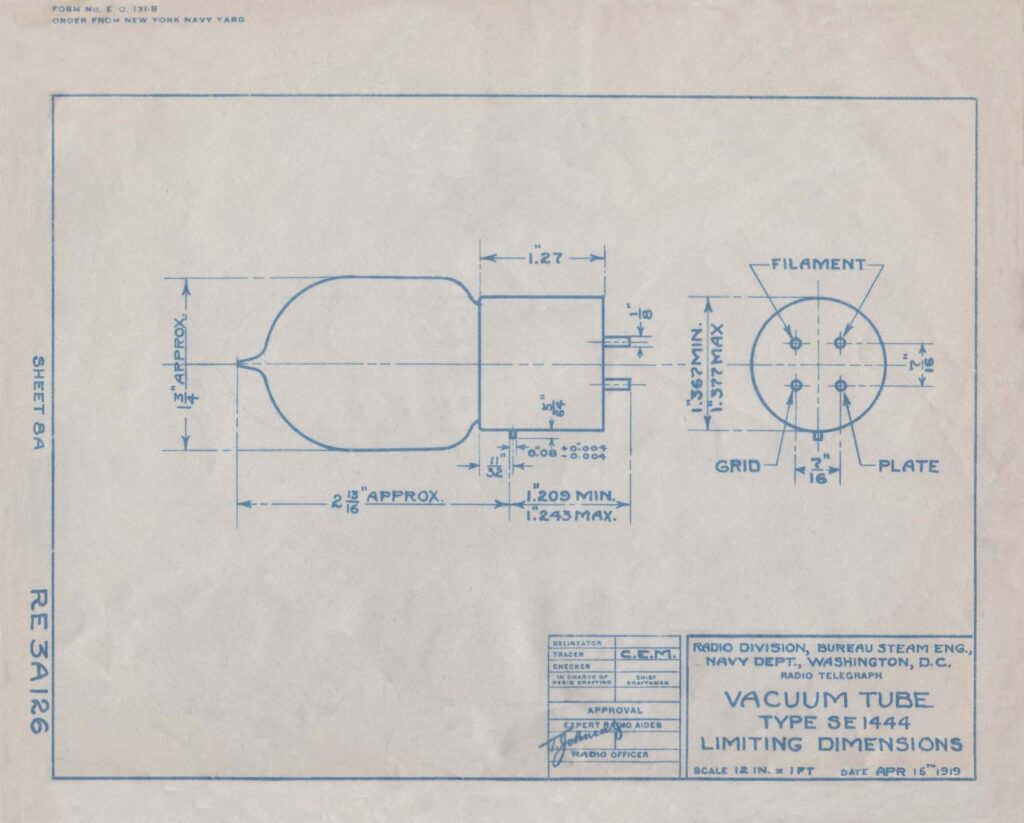
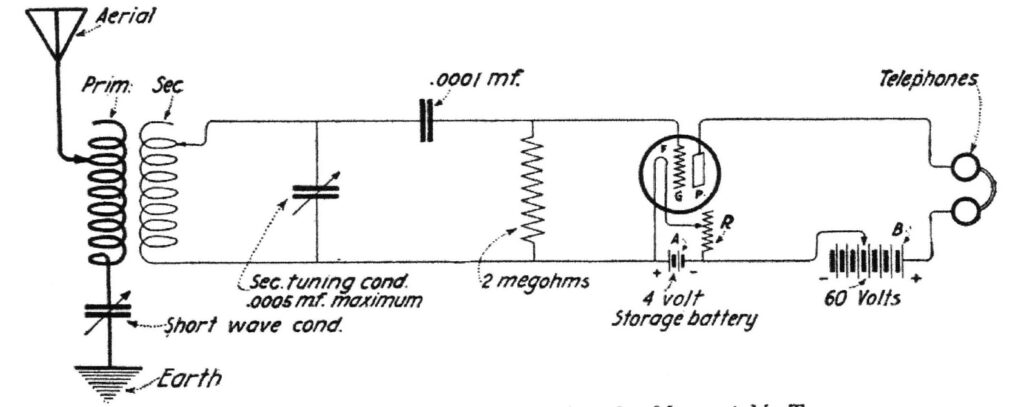
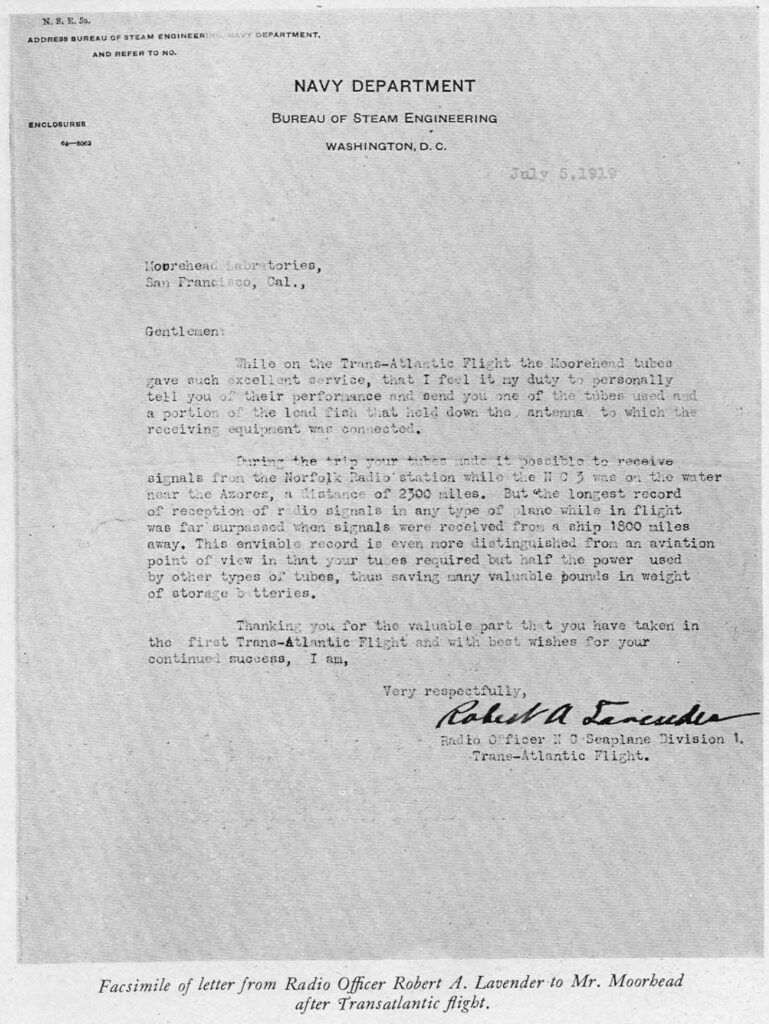
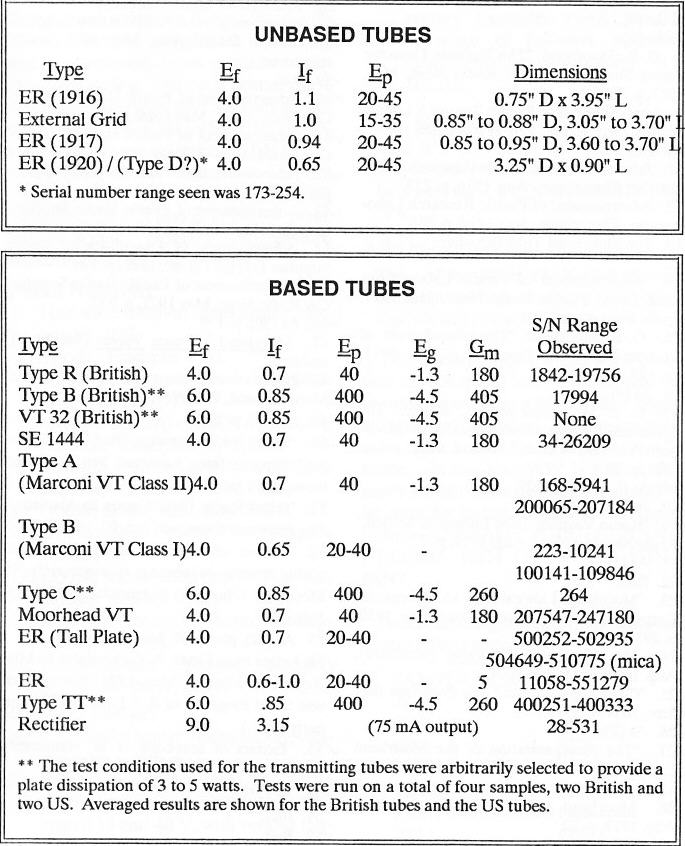
Fig. 12. This the US Navy SE 1444 outline drawing sent to Moorhead to make this type tube.
Fig. 13 Hook up instructions for the SE 1444 from the box.
Fig. 14. This is the award Moorhead Labs received for the exceptional performance of the SE 1444 in the first transatlantic flight.
Fig. 15. The serial number range for Moorhead company tubes was compiled by Will Jensby, Bill Condon, Jerry Vanicek and to a lesser degree, this author and others, many years ago. It was made by participating collectors submitting their known Moorhead tube serial numbers. I have a few that never made it on the list and other collectors may find they have some additional numbers that could be added. About this time a large article appeared in the San Francisco Chronicle about Moorhead and can be read here: SFC
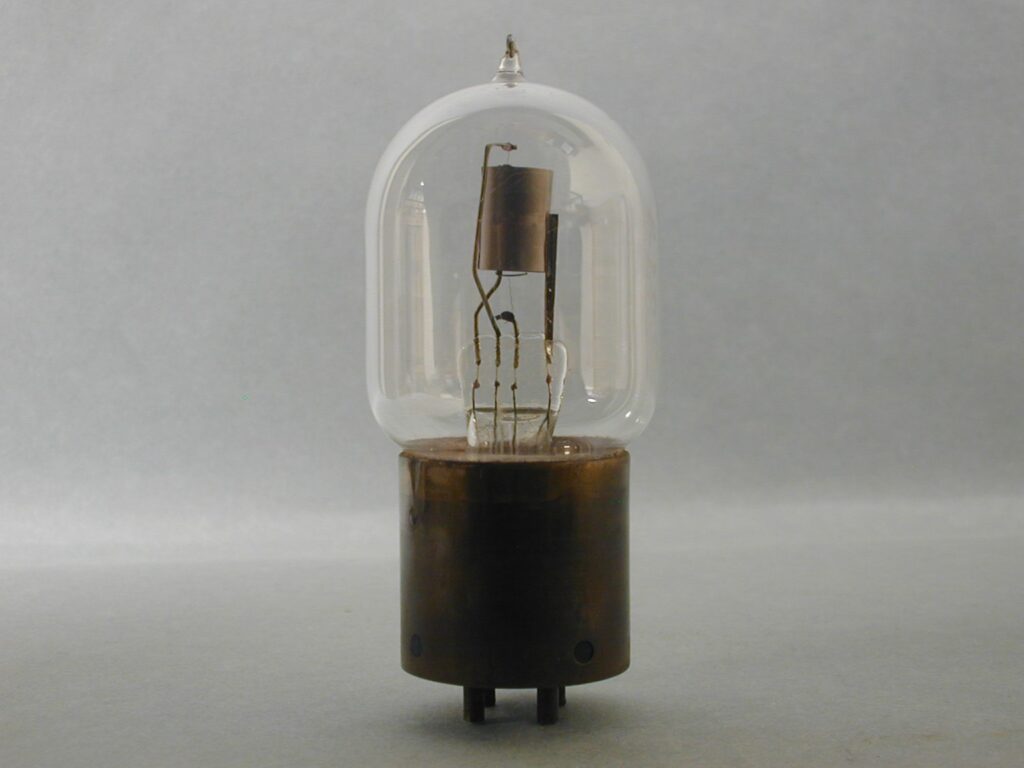
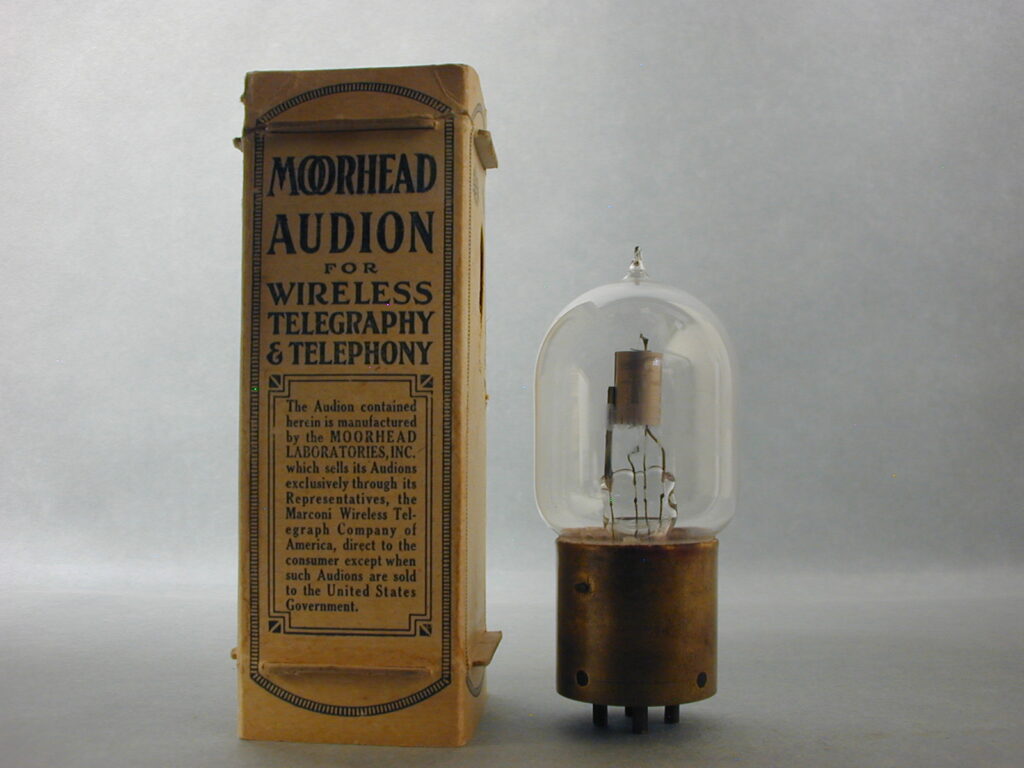
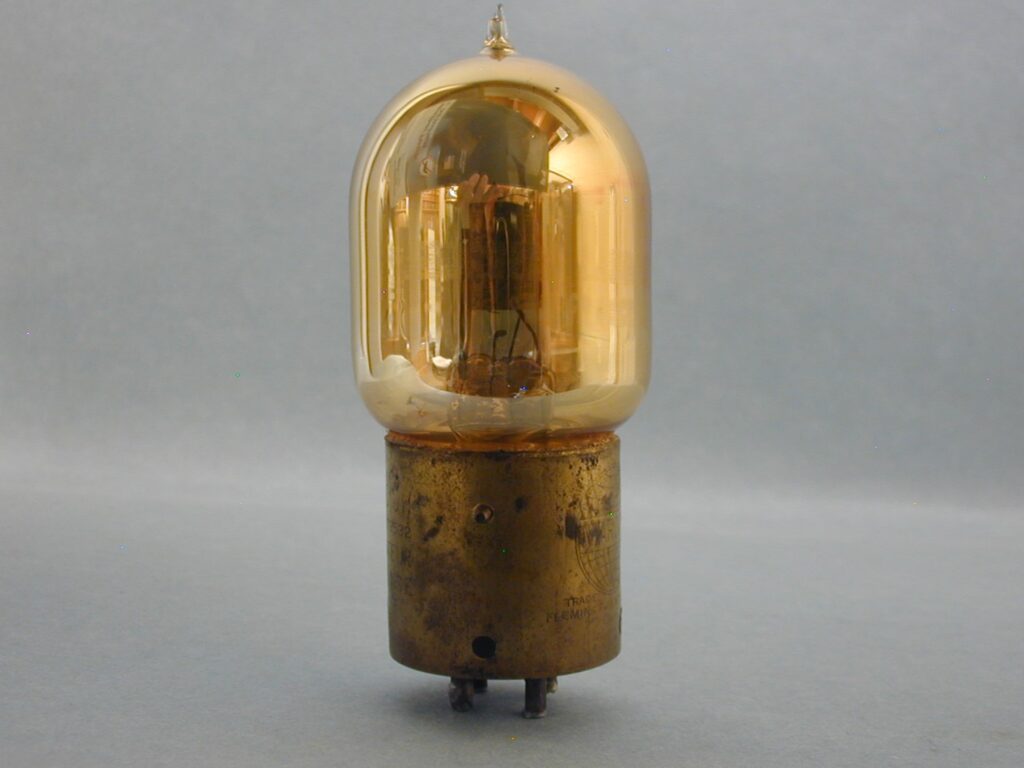
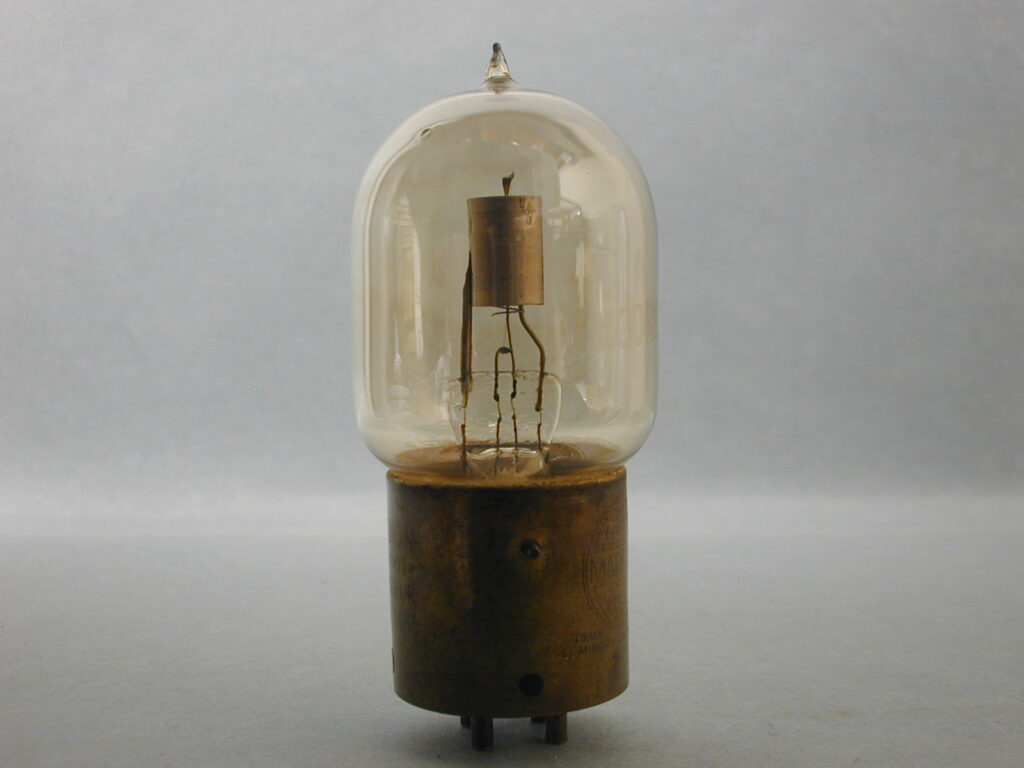
Fig. 16. Moorhead SE 1444 from 1919 with a clear bulb. It would be safe to say that the numbers of phosphorus to clear tubes of this type are about half and half. For some reason, the base of this tube was used previously as the pin has been re-located from its use as a Pliotron, CG 1162. Tube bases must have been hard to get at this point in the war.
Fig. 17. Moorhead hard tube type A, class 2 from early 1919. An A is etched on the bulb. This an early form of the box artwork after the contract between Marconi, DeForest and Moorhead had come to an agreement following WW1. Before this time, except for wartime made tubes, that anyone could legally sell a triode. Please read the wording in the rectangular box on the front of the box as it must have not been acceptable to Marconi as it was soon changed. The portion regarding “such audions are sold to the US Government”. Remember this wording as another type box will show a reaction from Marconi. Perhaps Moorhead or Henry Shaw, now the president of the Moorhead companies, were going to able to sell these audions to the US Government. That did not happen and changes were coming. This type could have a A etched on the bulb, an A on the press or class 2 in ink on the base or 2 on the press. All non-war Moorhead made A and B tubes were early versions of the of those supplied to Marconi under their new contract. Later, Marconi insisted that shipping cartons be made to have the Marconi and VT markings on the boxes and tubes. This switch-over was not immediate so many boxes were made as seen in fig. 17. After WW1 ended, the litigation between DeForest and Marconi was re-instated so no company could legally make a triode vacuum tube. Otis Moorhead broke the stalemate by making a deal with DeForest/Marconi to share their patents. He would become the agent between the two. See the Radio Amateur News articles explaining the new contract here: LIS
Fig. 18. Moorhead type A class 2 with a phosphorus getter. An A is etched on the glass bulb along with the Marconi and DeForest logos. There are more clear bulbed type A’s then those with phosphorus getters, owning to the fact that phosphorus may have been hard to get following WW1.
Fig. 19. Unless the A in ink was worn off, this tube is not marked as to what type it is anywhere, however, it does have an early, lengthy warning and patent info that appears on some very early A and B Moorhead tubes. We can still figure out it is a A tube by the serial number–206896. I will add the serial number reference made by Will Jensby many years ago. As can be seen, this serial number falls into the class set of numbers for an A tube. The A could have been left off on purpose as it is well known that Henry Shaw sold many thousands of tubes after the contract with Marconi was cancelled. No serial number would have made it hard be known as an illegally made tube. Please see the article by Eric Wenaas in Vol., 27, 2014 of the AWA review to shed much more light on this subject.
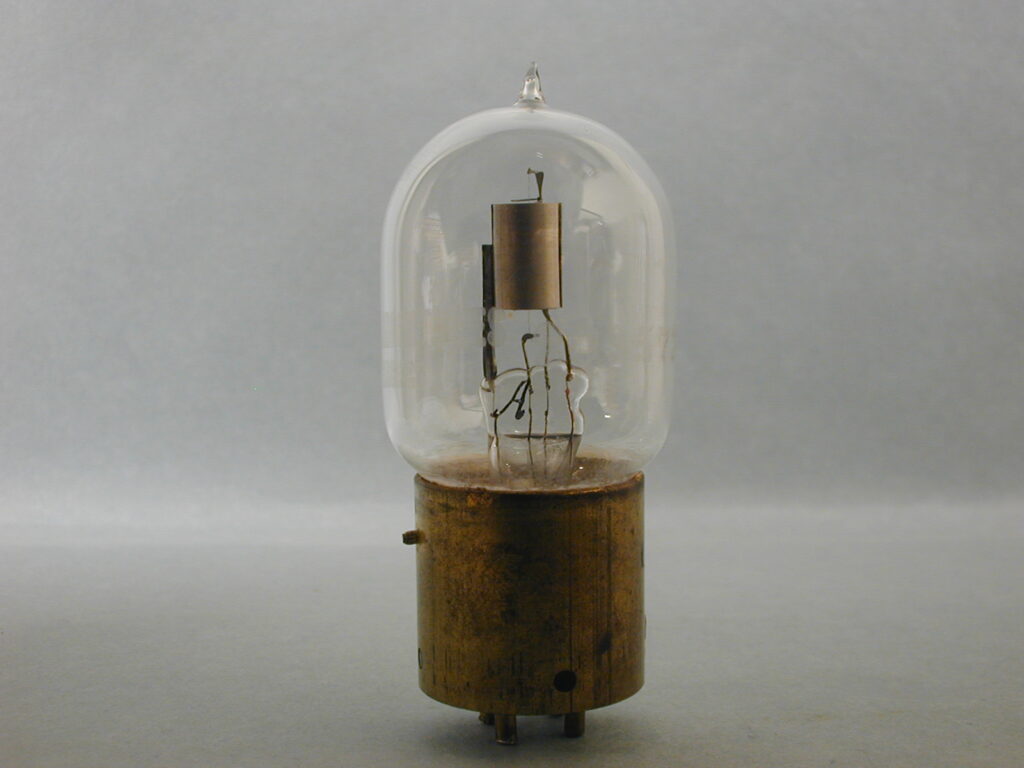
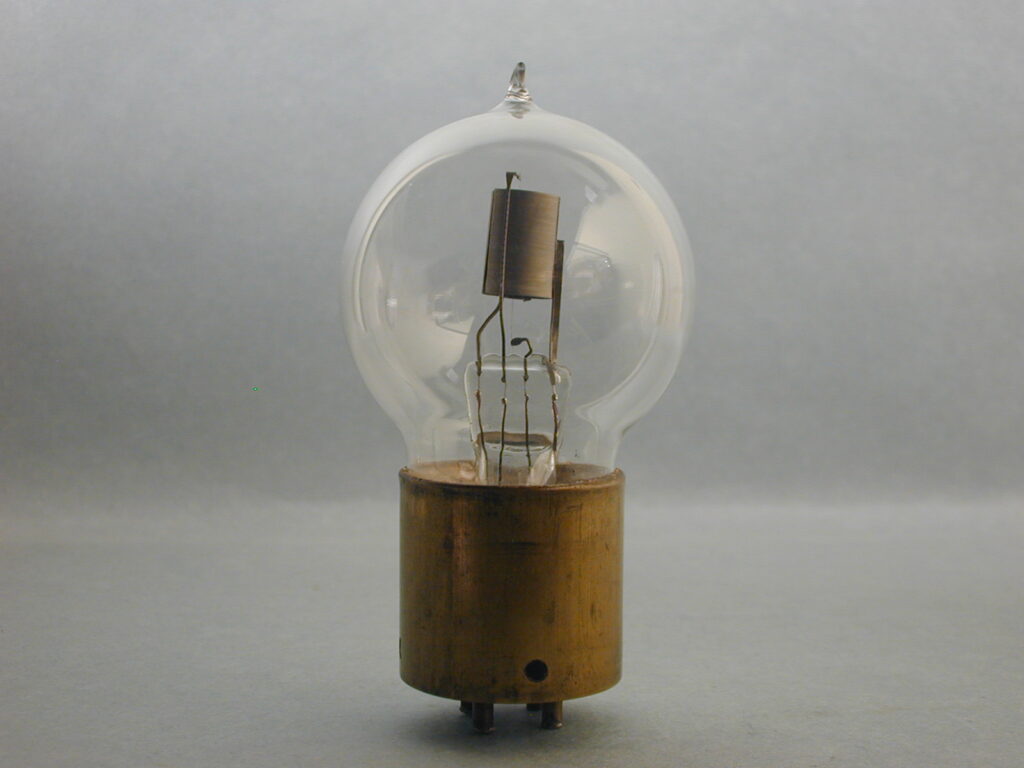
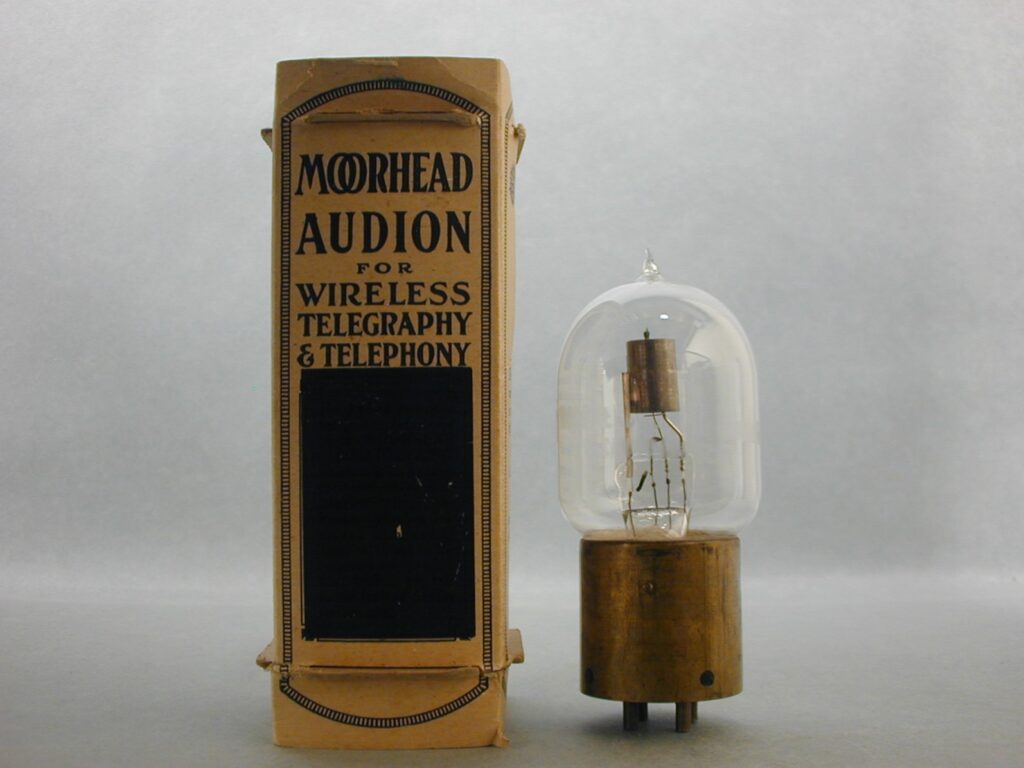
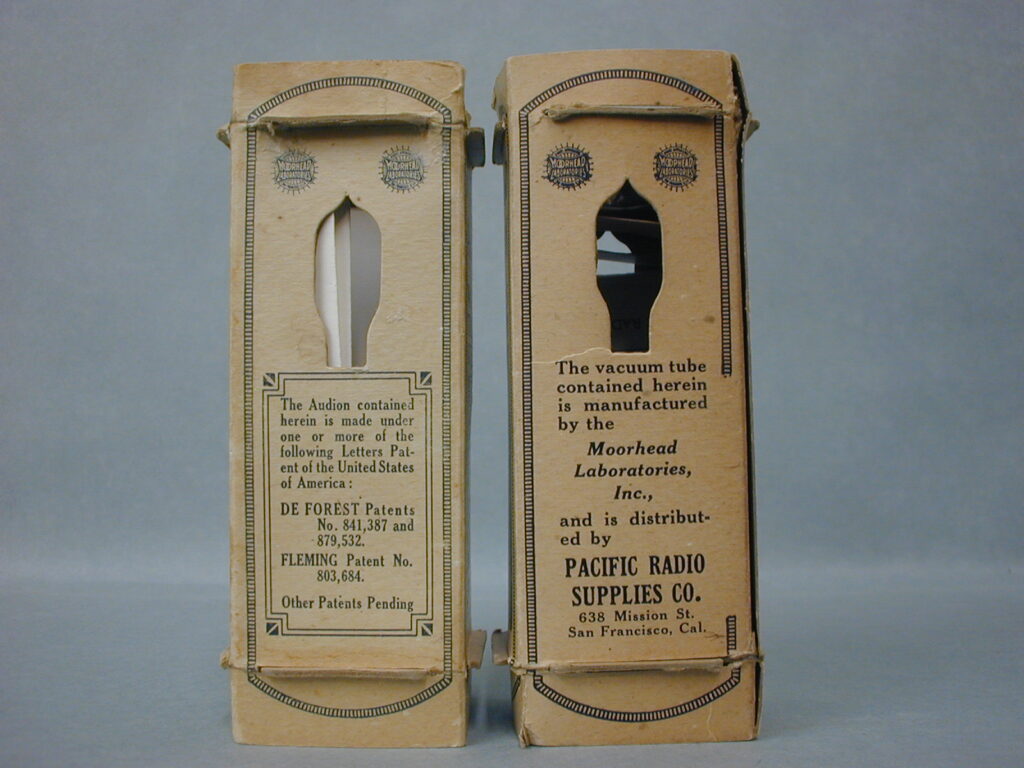
Fig. 20. Moorhead A type soft tube with the identifying A written on the press and class 2 written vertically in ink on the base.
Fig. 21. Moorhead A soft type spherical with A etched on the glass bulb. The spherical bulb is semi- rare in this version.
Fig. 22. Moorhead B type with the B appearing on the bulb, 1 on the press, and class 1 in ink on the base. Reference was made about the wording on the box in fig. 17 and how Maconi may have wanted his name to be more prominent on the cartons and some of the wording to be eliminated regarding sales to the US Government. Moorhead Labs started with blacking out the wording as can be seen in fig. 22. Later, the box design would be changed again to include the Marconi logo with DeForest getting a small mention in small letters on the bottom. The box in fig. 22 does have some wording on the side panel that the box in fig. 17 does not have. Henry Shaw is now president and added the distribution name to Pacific Radio Supplies Co. but retained it was made by Moorhead Laboratories Inc., and kept the Moorhead Laboratories Logo. Very odd.
Fig. 23. The box on the left is from fig. 17. The box on the right indicates the new wording that was added. Please review the boxes in fig. 23.
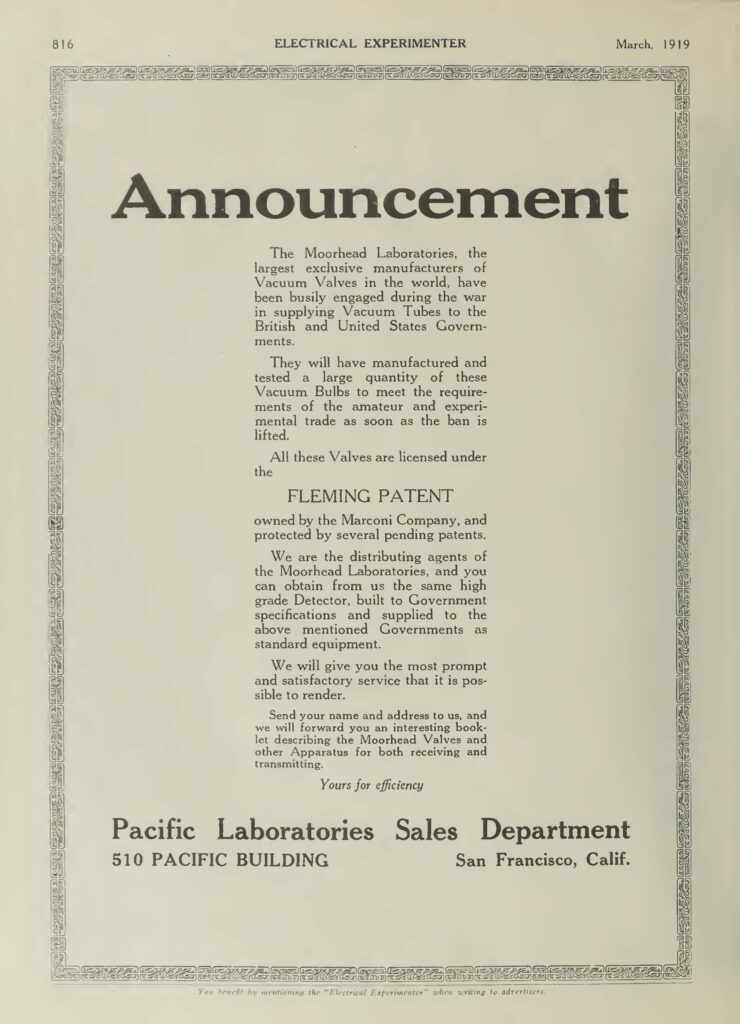
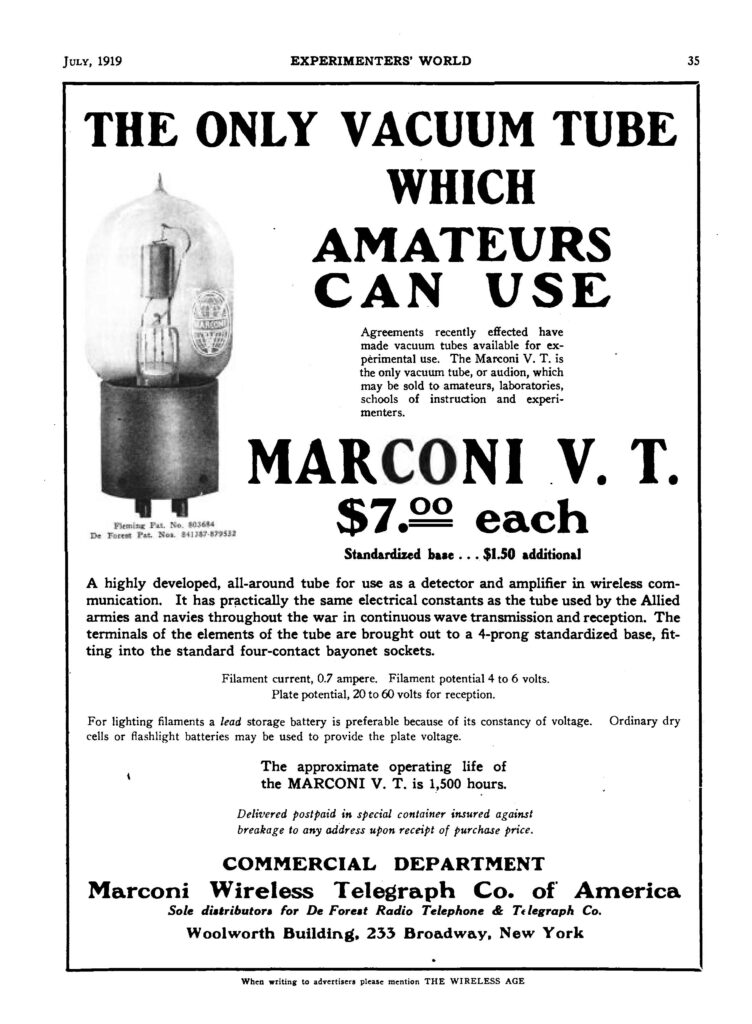
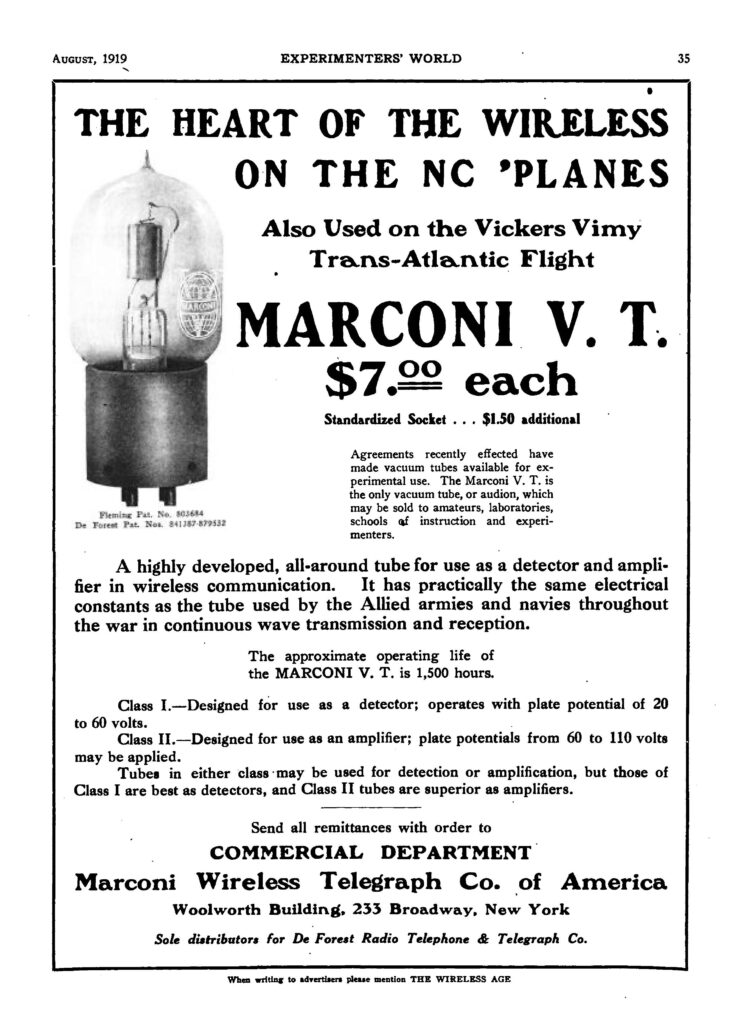
Fig. 24. Although the final details of the Moorhead/ Marconi/DeForest contracts were still in negotiation, Moorhead was making hard tubes A, class 2 & soft tubes B, class 1, Moorhead took out an ad in early 1919 announcing their intentions. About this time Moorhead approved a large sale of stock in his company indicated by this article in a San Francisco newspaper here: MS_O Stock sales continued for at least a year until enough working capital was attained. Some stock certificates were signed by Otis Moorhead and some by the board of directors’ member Henry Shaw. view here: MS_H
Fig. 25 and 26. Marconi insisted that the new Moorhead tubes now be called the VT, as can be seen in the ads. The changes in the contract would mean a new design in the shipping boxes. Compare the wording in the July and August ads above. The July ad simply mentions the new Marconi VT while the August ad, for the first time mentions the Class 1 and class 2 tubes being offered. The hard A class 2 was to be used a detector and the soft B class 1 as an amplifier. The American Marconi Co. disliked the soft tubes and thought the hard versions were a much better all-around choice. Amateur operators, however, thought the soft tubes, when used correctly, gave them much better sensitivity, and preferred that version, similar to the Deforest audion, under certain conditions, could be an amazing receiver. This fact did not resonate with Marconi and their sales suffered. Also, the shipments of both types, A and B from Moorhead showed a good percentage did not work. It was later found that Marconi’s testing methods were faulty and with the proper testing, the tubes considered faulty would have been very low. In any case, an article on testing of the Marconi VT’s, from the magazine “Wireless Age” in 1920, was too early to be considered a good method. Never-the-less, the article can be read here: TM_V.pdf
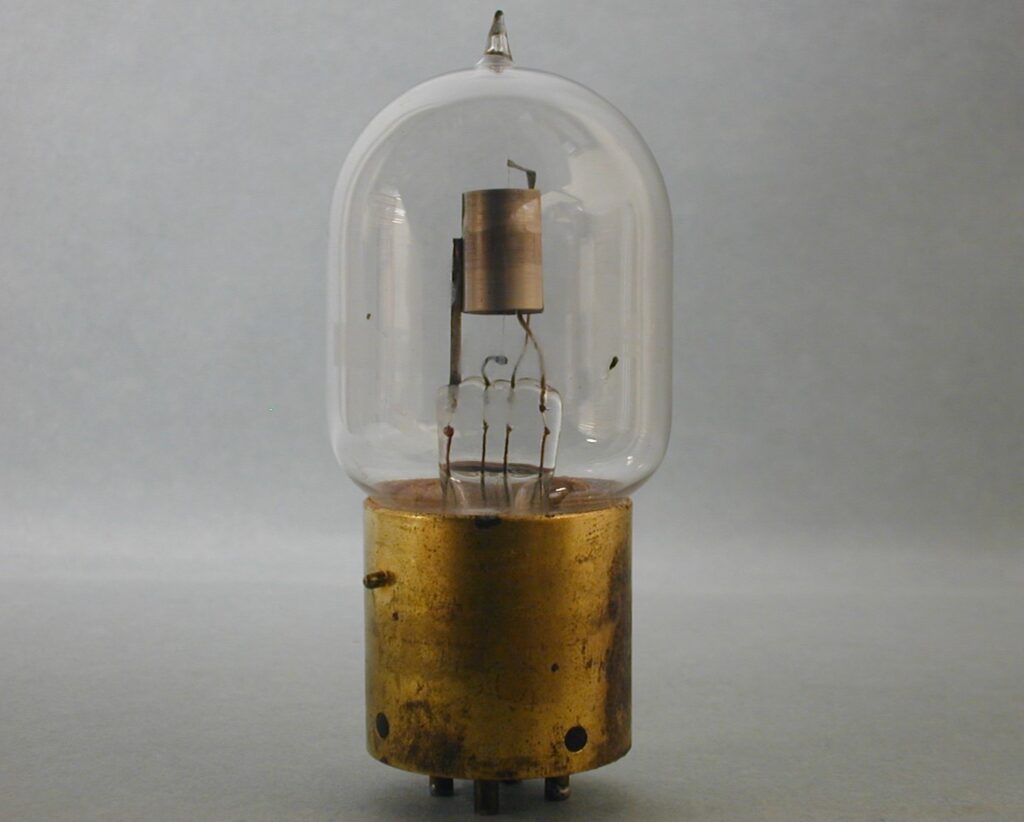
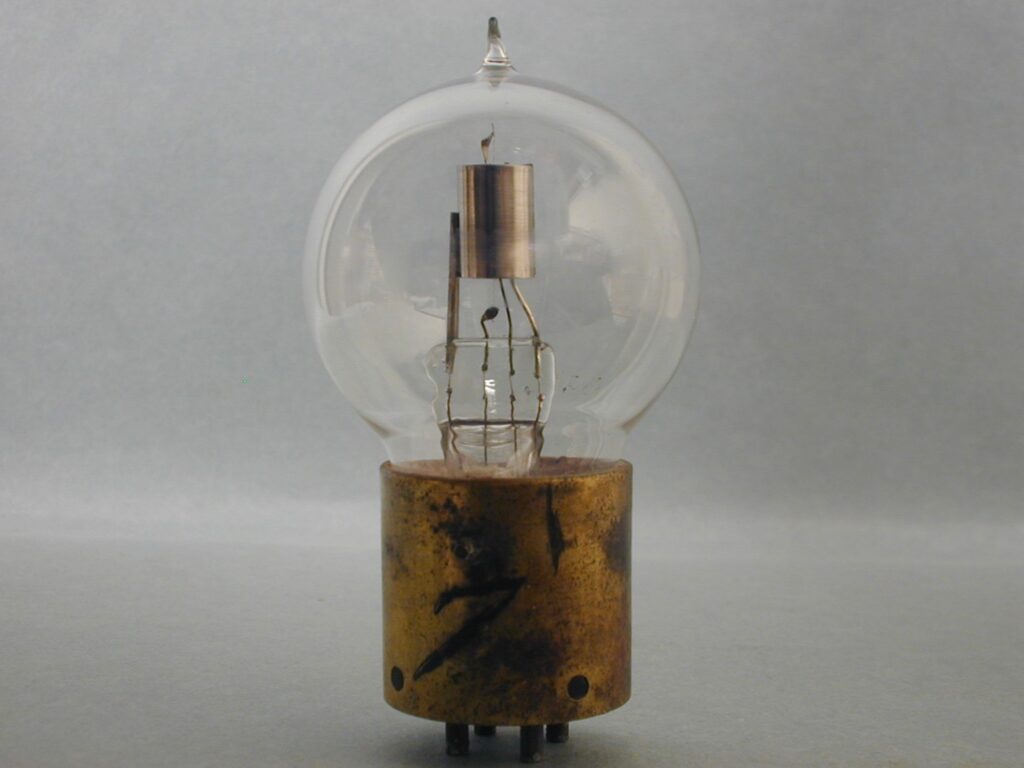
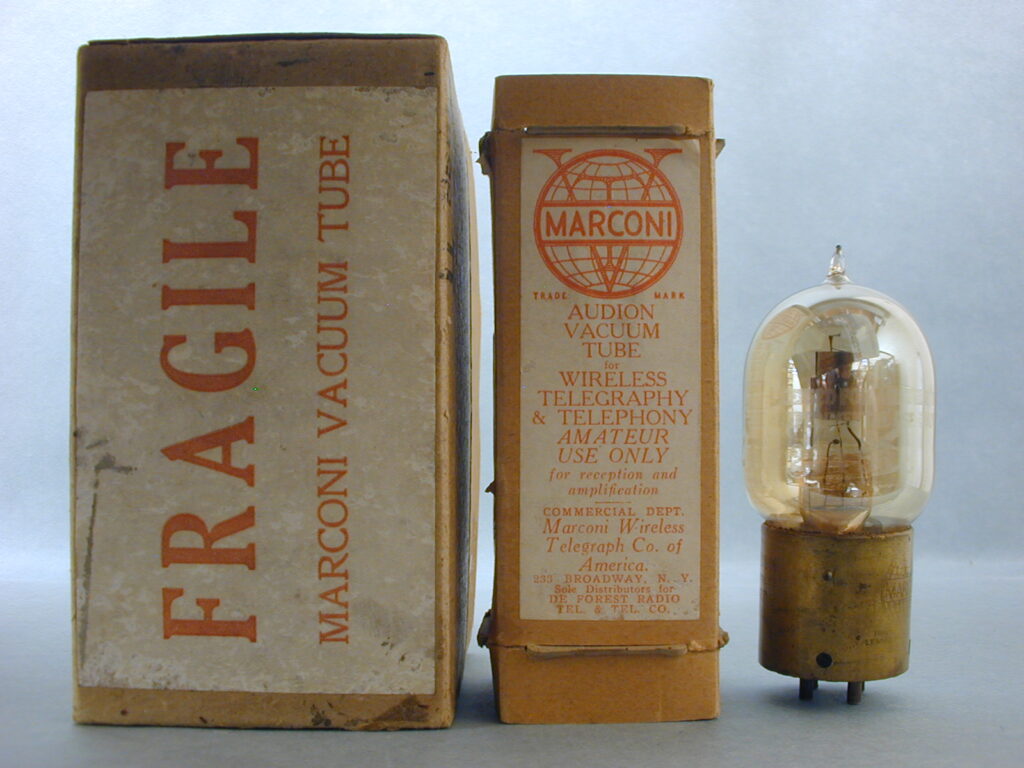
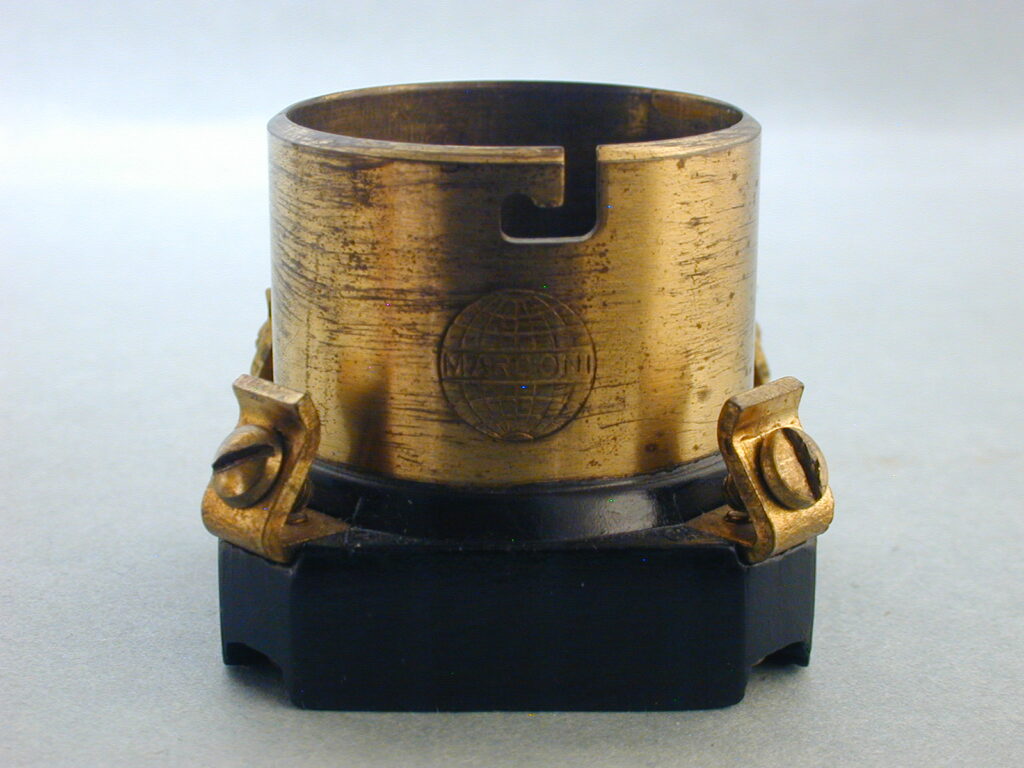
Fig. 27. This is the soft Moorhead B class 1. B is etched on the glass bulb. Generally, there are more surviving A’s than B’s simply because they were preferred by amateurs as they were more sensitive than the A’s.
Fig. 28. B is etched on the glass. The spherical B is quite rare and are quite hard to find.
Fig. 29. The second Moorhead/Marconi/DeForest contract has taken hold evident with the newly designed Marconi artwork on the box label, VT etched on the glass bulb and a new smaller and larger shipping container. Finding Marconi and DeForest logos pressed into the Shaw bases is becoming more consistent. A new tamper proof seal now holds the box together that has the Fleming and DeForest patents printed on them. Much to the dismay of radio amateur’s, Marconi soon dropped the sale of the soft Moorhead type B, class 1 tubes. They thought that the hard A, class 2 was a much better all-around choice. In looking at fig. 15 then, now all Marconi VT tubes would, generally, fall into the serial number range given there, except for a small number of soft VT’s that had a 1 on the press. This author has never seen one marked as such, however. Marconi spared no expense to add additional information in the shipping boxes of the VT. A .PDF of those can be seen by clicking here: MB_ALL
Fig. 30. Marconi had their own sockets made to complete the look along with another necessary piece of equipment and hookup instructions. The Marconi logo can clearly be seen pressed into the base.
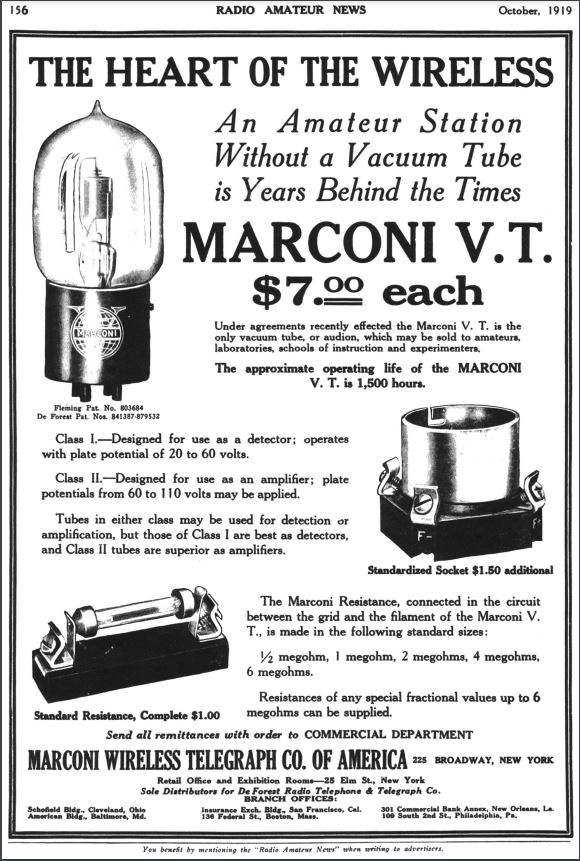
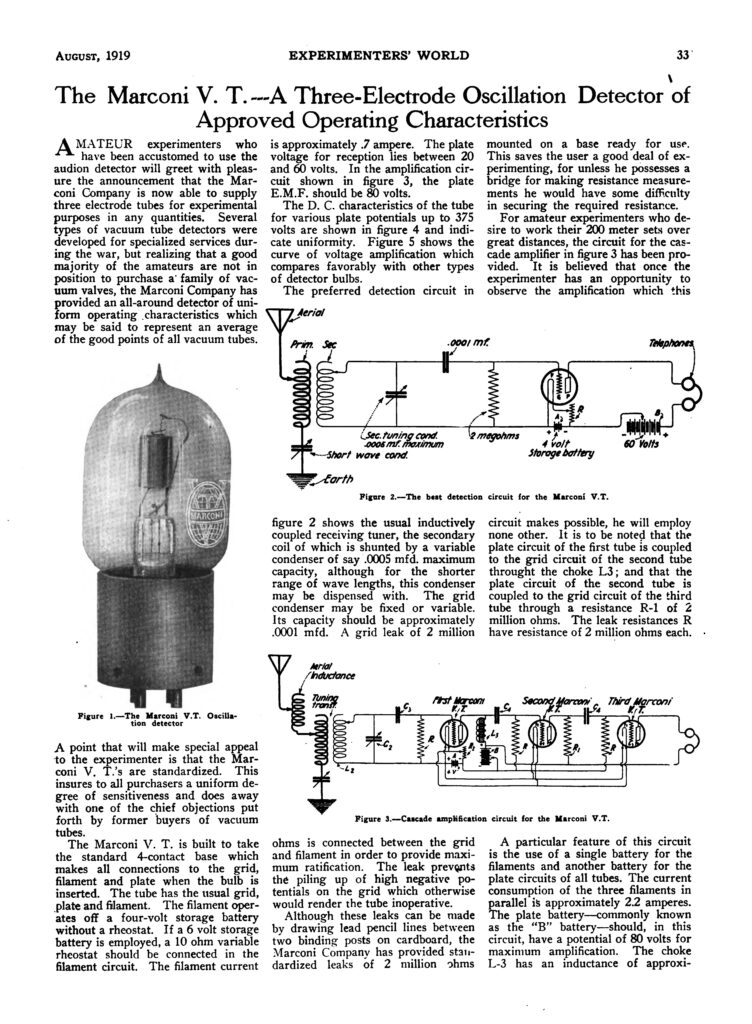
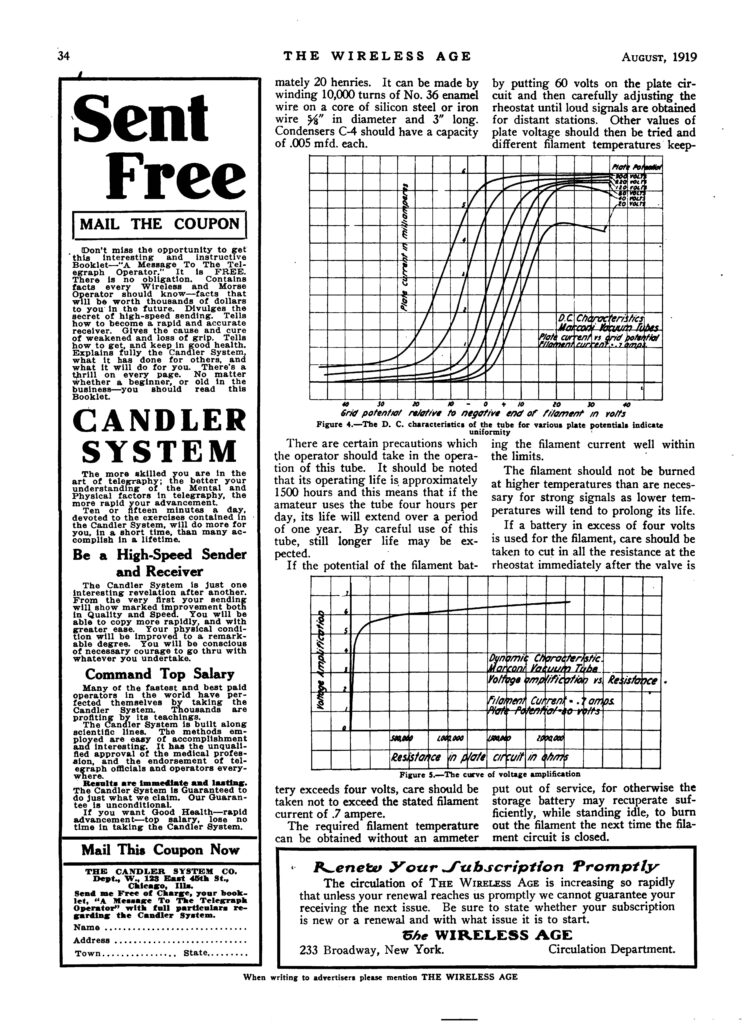
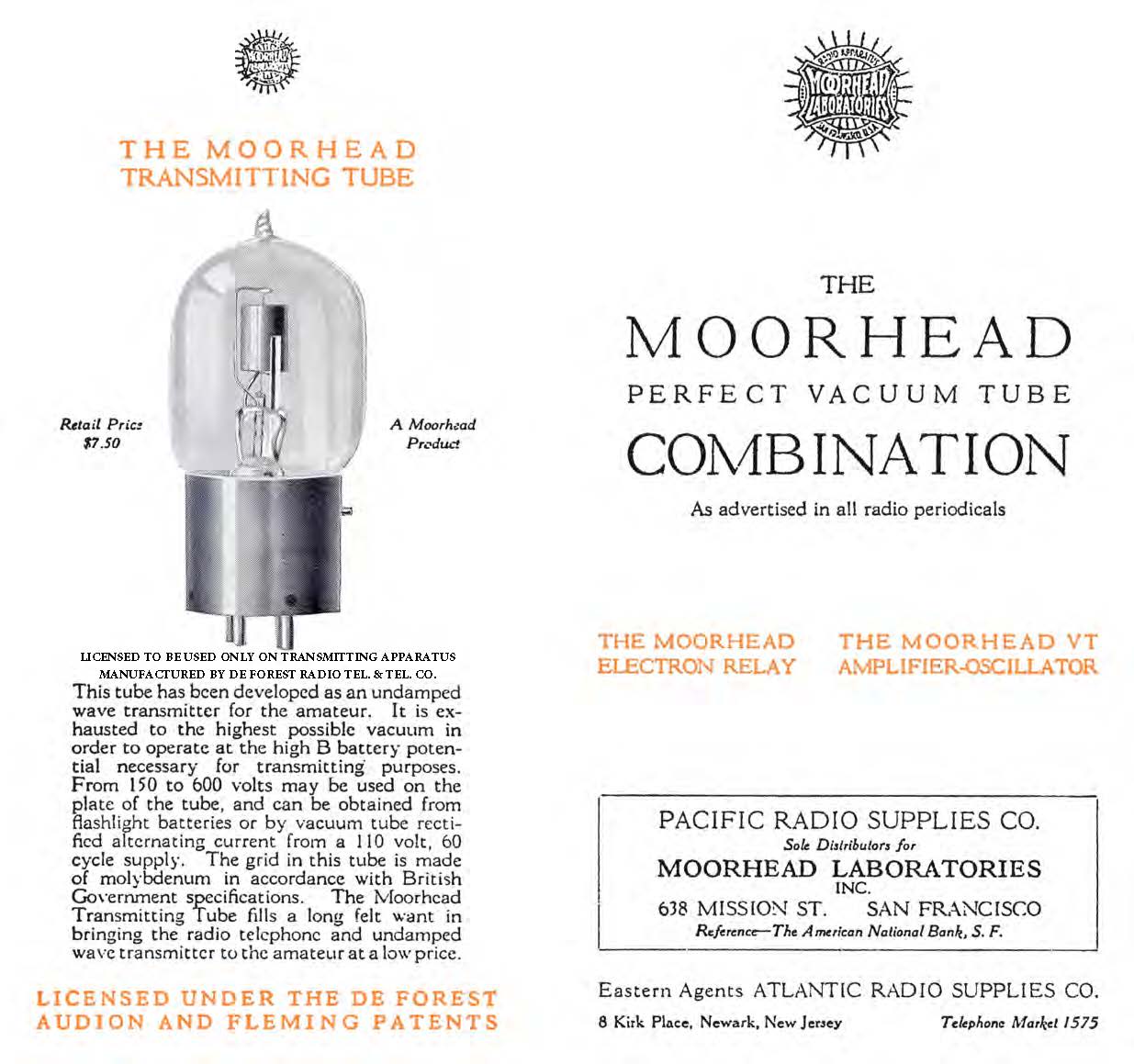
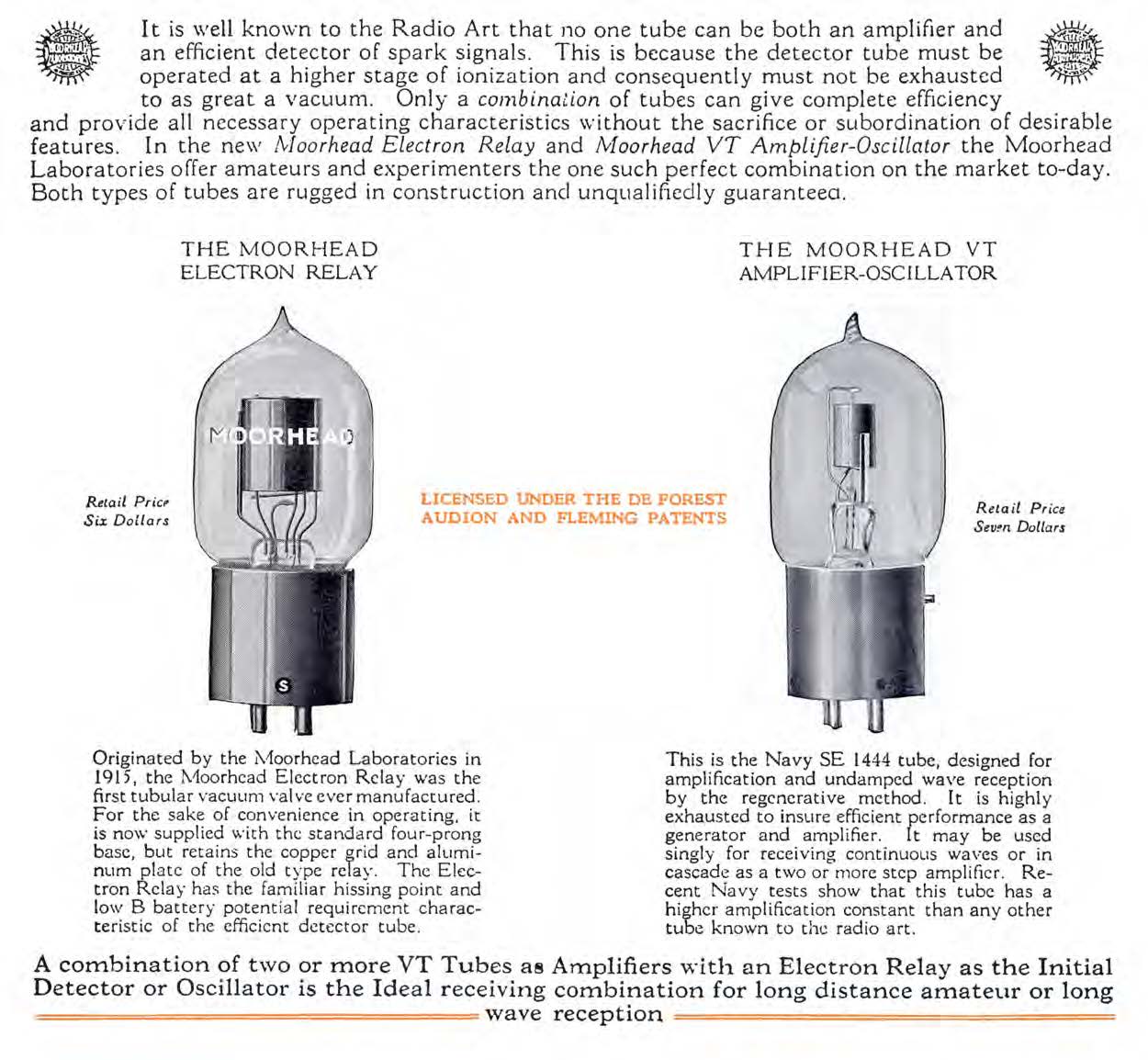
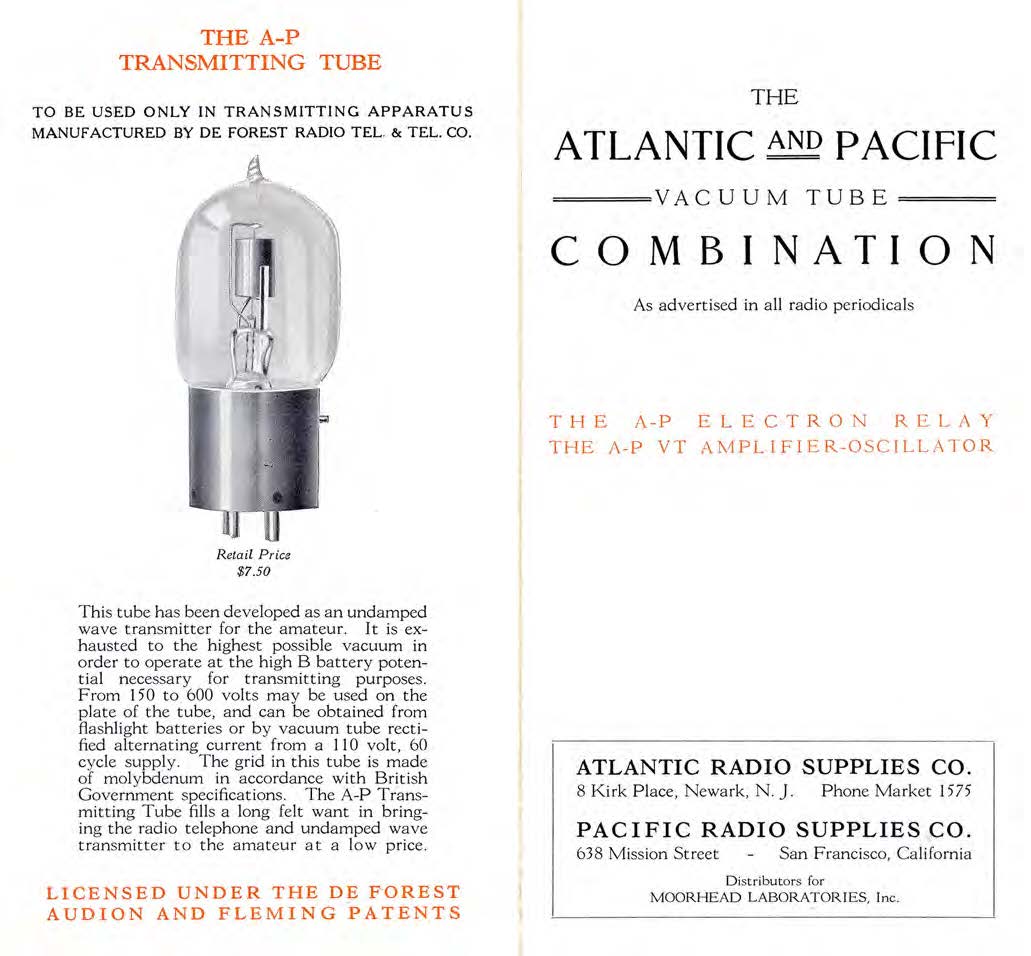
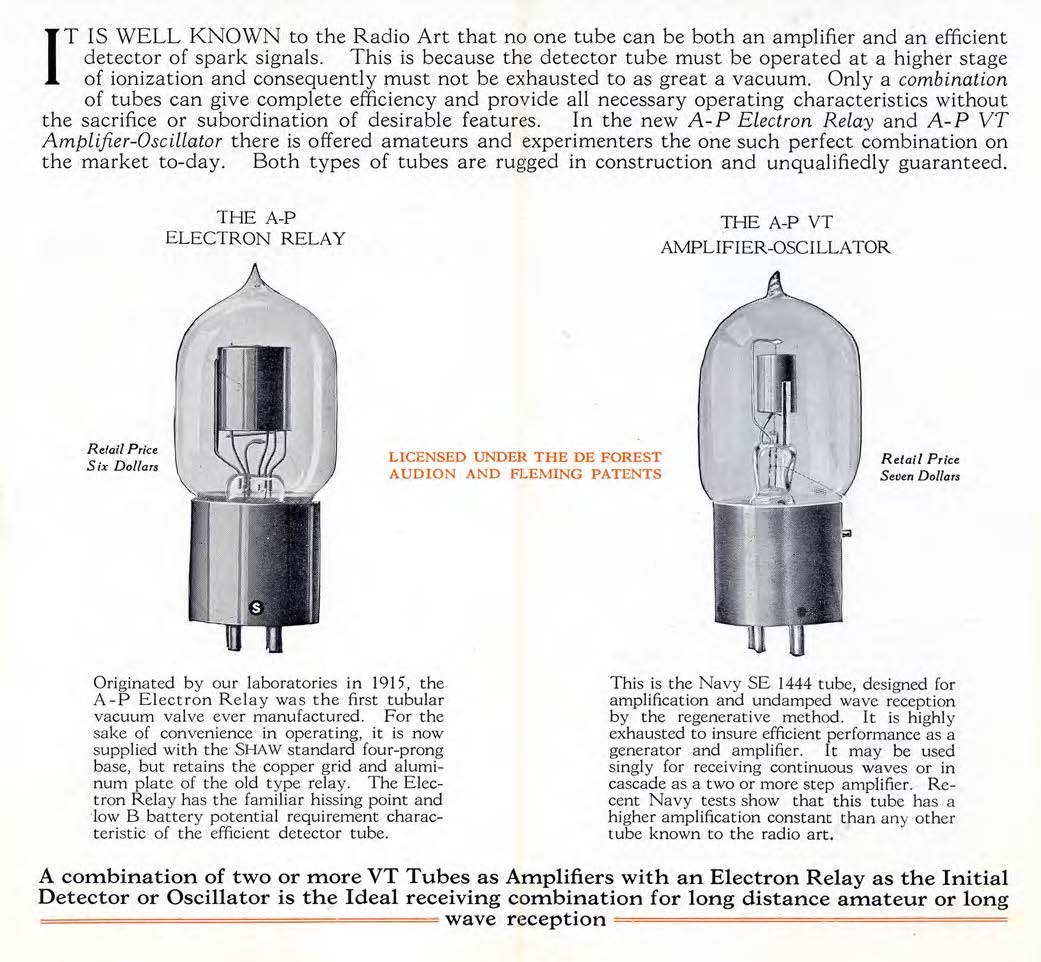
Fig. 31. Marconi Wireless Telegraph Co. of America ad for their VT, VT socket and resistance and block.
Fig. 32 and 33. This article appeared in The Wireless World explaining how amateurs will be thrilled to learn that Marconi is going to offer only the hard version type A class 2 as this is the best all-around tube made. The amateurs were not impressed that the B class 2 soft was being dropped from production. The new VT was exactly the hard SE 1444, the Moorhead, 1918 war time tube.
Fig. 34 front and back and fig. 35, 2 middle pages. The transition from Moorhead as president of the company to Henry Shaw can be seen in this brochure, around Oct., 1919. It states Otis Moorhead’s Moorhead Labs as the name is making the new VT, a new transmitting tube, and the soon to released and re-designed Electron Relay. Moorhead had much financial difficulties in what seems to be a court document, may be some of the reasons. Click to see the document here: CONT Also, these 3 newspaper articles will help explain the problems Moorhead had at the time here: NEWS Chain of events that led to Moorhead losing his position are as follows- About Nov., 1919, the US Government set up a new company, RCA, for reasons of national security, to be merged with American Marconi. All contracts with Moorhead and DeForest were cancelled via a letter sent o Moorhead. A new investor board of directors, led by Willard Williamson, decided to close the factory on Jan., 1920. In March, 1920, Moorhead sent a telegram to Henry Shaw. Shaw had a great deal of money invested with Moorhead Labs and immediately arranged for a $50,000 bank loan. The board reorganized the company again and named Shaw as president in April, 1920. An article appeared in the Pacific Radio News regarding the re-organization of Moorhead Labs Inc. Click to read it here: RE_ORG.pdf
Fig. 36. Front and back and fig. 37, 2 middle pages. Moorhead is now not mentioned in this brochure and Henry Shaw has changed the name to Atlantic-Pacific Radio Supplies Co. or A-P for short. The Moorhead Labs logo is gone as well. Same tubes offered with a new name of the company. With Shaw as president now, Lee DeForest joined him in acquiring 75% of the stock of Moorhead Laboratories and Shaw holding much of that. Otis Moorhead was named chief engineer and now worked for the company he started. See the “NEWS” article above for the new companies’ statements. DeForest had his own newly formed company called “Lee DeForest Inc” in San Francisco. Several new products and tubes will be introduced. See article regarding this here: DFR
An explanation of the Moorhead Electron Relay’s shown in the brochures in fig’s. 34-37 will be forth coming starting in fig. 47.




Fig. 38. This tube, etched “Special” and while it is not mentioned as the “Special” in the two brochures front and back scans in figures 34 and 36, it is, in fact, the transmitting tube referred to. A close look at the grid shows 22 turns of wire.
Fig. 39. Even though the contract with Marconi was cancelled, that in no way was going to prevent Shaw from continuing to make and sell the tube lineup. Several of the contracted VT tube shipments were cancelled so they were already made with the materials to make many more on hand. Shaw had newly designed shipping boxes made with the A-P wording and stamped VT. Fig. 39 shows this new box and the clear bulb etched VT, same as before the cancellation. This particular VT has a smaller plate and the word “Detector” vertically inked twice on the base. This means this tube is the soft version like the B class 1 and the grid has less turns. The serial number on this tube is 212788 and falls within the range shown in fig. 15 but this range data does not differentiate hard tube from soft tubes. Quite rare to find this.
Fig. 40. Same style box marked VT but the tube has a phosphorus getter. The serial number etched is 211269 and falls within the range shown in fig. 15. Find a scan of the original document in which Moorhead made tubes, in a specific numbered sequence, have been duly received by the Marconi Wireless Telegraph Co. of America with the receipt stating 50 audions received that closely match the etched number on this tube. Here: MTR
Fig. 41. Very unusual VT bulb shape but etched VT. The box is different in that it is taller than all the others. This odd tube was purchased from a collector in Washington State and claimed that it was made in a small Moorhead factory in British Columbia. This of course cannot be verified but Moorhead did travel to Washington State for meetings with shareholders. This newspaper clip gives a bit of possible truth to the story and can be read here: MGN
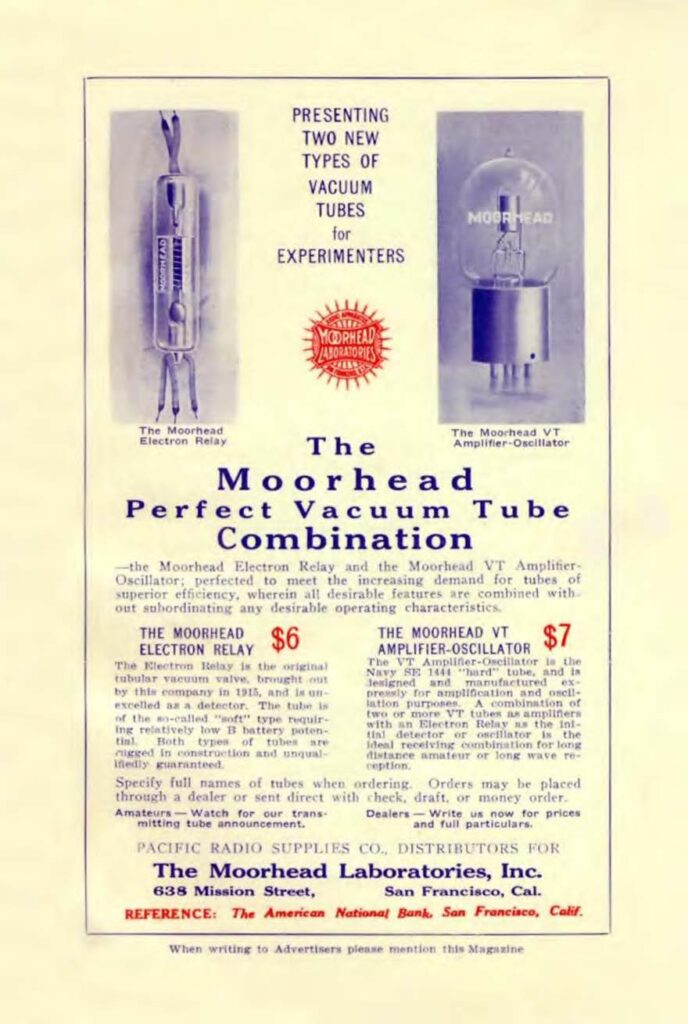
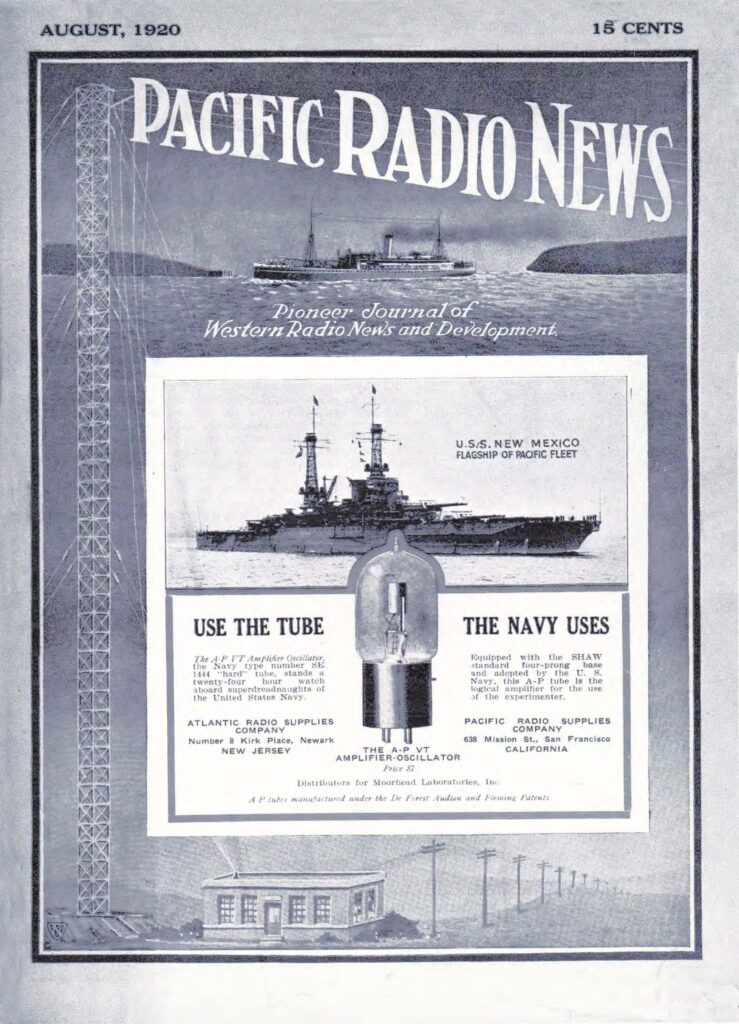
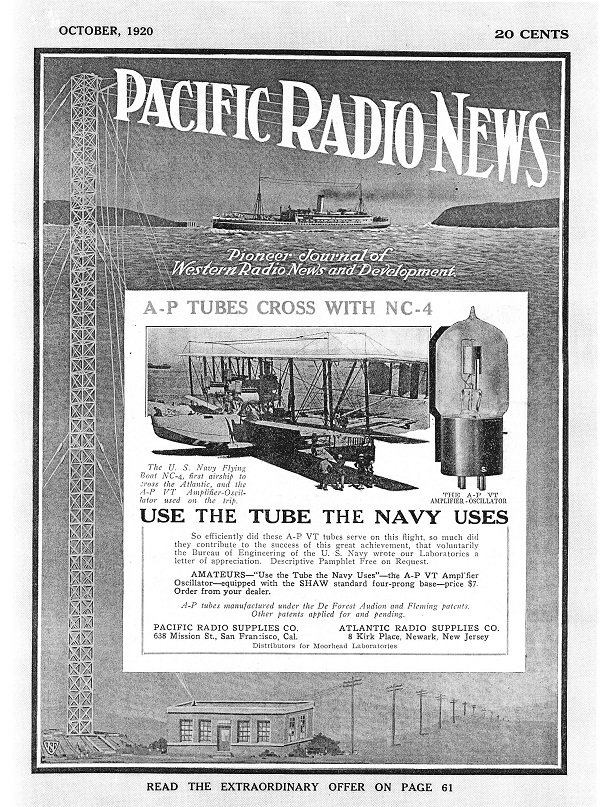
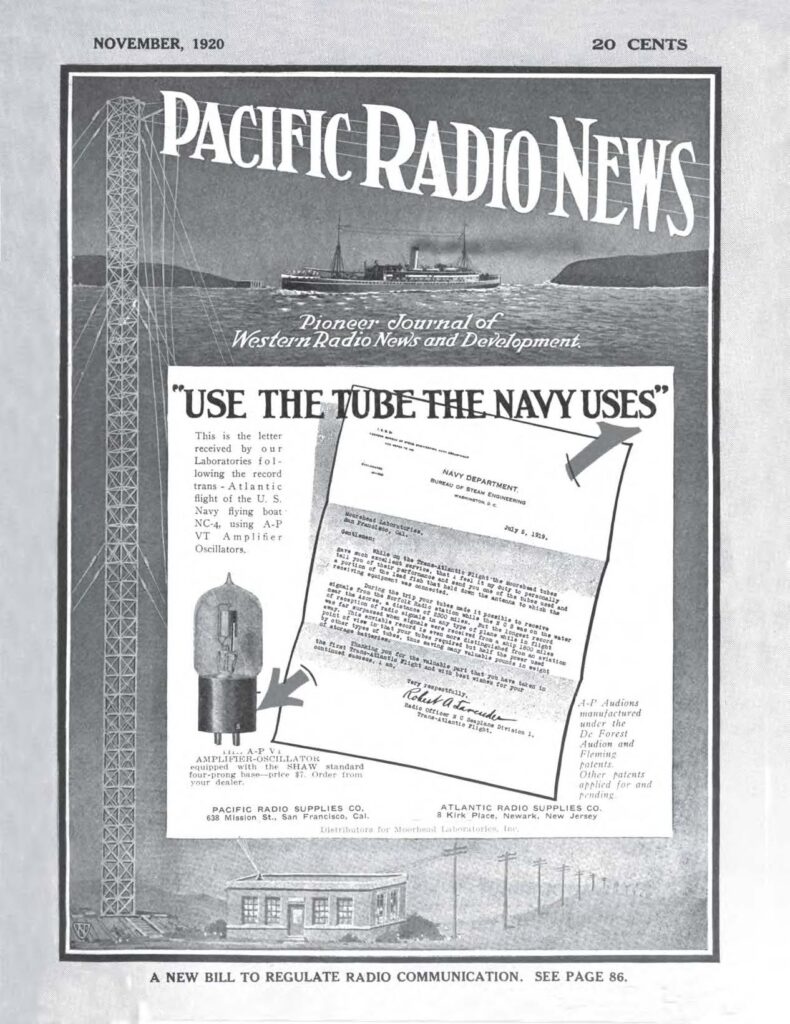
Fig. 42. One of the first ads Shaw, now president of the A-P Co. presented included the un-based Electron Relay. A-P did not have a new design for the E.R. yet so this soft tube, that amateurs loved, was offered along with the hard VT. Apparently, there was no time to have the ad altered to state A-P Labs which would have been correct at this time.
Fig. 43. Shaw put in all the effort to make sure the subsequent ad placed in the Pacific Radio News did state the new name of the company reminding all users that the hard VT was the war time tube SE 1444 that the US Navy used in WW1.
Fig. 44. In this ad, Henry Shaw is cashing in on the fact that the VT named is the very same tube as the SE 1444 that played a large part in the successful first crossing of the Atlantic in 1919. Please read more about this historic flight. Part 1 here: https://vacuumtubearchive.com/vacuum-tubes-used/ Part 2 here: https://vacuumtubearchive.com/wp-admin/post.php?post=6997&action=edit
Fig. 45. Here is yet another ad now stating the A-P VT is for sale showing the letter Moorhead received from the US Navy while using the SE 1444 in the first Trans-Atlantic flight.




Fig. 46. We cannot move too far from the 1920 period without mentioning the type 20. We now know that DeForest became a shareholder in the newly formed Atlantic-Pacific Radio Supplies Co. and the tube in fig. 46 leaves no doubt that this is his design. An ad for it appears in the May, 1920 issue of the Electrical Experimenter. No picture of either tubes in the ad makes one wonder if it was actually made at all. Why mention it then? It is unusual in that it has pat appl for and DeForest etched into an arch around the evac. point. This author is one who believes that the tube was made in small quantities but larger amounts delayed for some reason and became the DeForest DV6. I have another version that has the same wording pressed into the base and etching but it also has the extra wording like the DeForest 6A. It is possible that the first version mentioned is in fact the type 20 while the second version is the DV-6. We will never know for certain. For comparison to the type 20 or DV-6, look here: DV_6A
Fig. 47. By this time, Shaw and Moorhead had a newly designed tubular Electron Relay. It had a similar construction to the original but with a standard bulb shape but about the same sized plate. It was found in factory testing that if the plate were only supported once from the press, it was microphonic so 2 arms were added to the bottom of the plate and bent in to touch the press to fix the problem. The soft tube was welcomed by amateurs. A new design with Atlantic-Pacific and E.R. inked on the box completed the look.
It must be noted, Henry Shaw and his chief engineer, Otis Moorhead knew they were making and selling illegal tubes, yet they continued on making and selling. Even when the Moorhead/Marconi/DeForest were in force, many thousands of VT duplicated serial numbered tubes were found by RCA to have been made and sold in violation to the contract. When confronted with the facts, Shaw managed to cut a deal with RCA to sell the remaining tubes under their contract that were never delivered. Several wording mistakes by the lawyers of RCA allowed much room for Shaw to gain the upper hand in this short- lived contract but once that ended, it was a fact that RCA had a clear-cut case of patent infringement against Moorhead and Shaw A-P labs starting in July, 1919, the day contracts with Marconi ended and RCA held all the necessary patents. RCA sent letters to A-P warning them to discontinue sales but it was clear, considering all the new ad’s Shaw was placing all over the country that he was ignoring them. However, RCA was a bit leery to initiate a legal battle considering they did not fair to well in their negotiations with Elmer Cunningham in early 1920. In trying to gain proof of A-P sales, RCA set up a spy network to on the west coast to monitor their sales and soon learned that everyone was selling and people were buying A-P tubes that could cut severely into RCA own sales that were to begin in Dec., 1920. Seeing RCA’s reluctance and with great negotiating skills, Shaw set up a meeting with Marconi and RCA in October, 1920. Shaw stated that he had many creditors to the tune of $150.00 and only wanted to pay off the debts. He proposed Marconi could grant him a temporary license to sell enough tubes to pay that off, perhaps 70,000 or so, and make it worth Marconi’s interest. He asked to sell an additional 35,000 tubes under the Fleming patent to satisfy the debt and in order to do so, would need control of the making, advertising, and he would pay a royalty of .60 cents to RCA, and further stated that he would stop making and selling tubes as soon as the agreed number of tubes were sold. Shaw admitted he had made and sold 10,000 of the 35,000 tubes already so the amount he could sell came to 25,000. RCA wanted royalties for the 10,000 tubes he had sold. Shaw claimed he did not have the money so RCA agreed to take 10,000 in materials. Shaw stalled RCA on this but finally delivered a million feet of tungsten wire to GE. RCA had experienced a bad outcome with west coast judges in the Cunningham case so they agreed with most of what Shaw wanted. [2}
Fig. 48. The improved version of the Electron Relay is shown here. The plate has been shortened to half the size but it only has one press support, therefore, it was still microphonic. After a short time, an improvement was made that added a second support. These 4 support tubes are quite rare to find and are generally called the short shiny plate types. The factory must have been short of the boxes shown in fig. 47 and a VT box was used instead but it was inked E.R.
Fig. 49. The second improvement is evident here as the plate now has 2 supports to the plate. It cannot be seen in the picture but nickel for the plates must have been hard to obtain but the plate on this tube has 4 welded splices to complete the circumference.
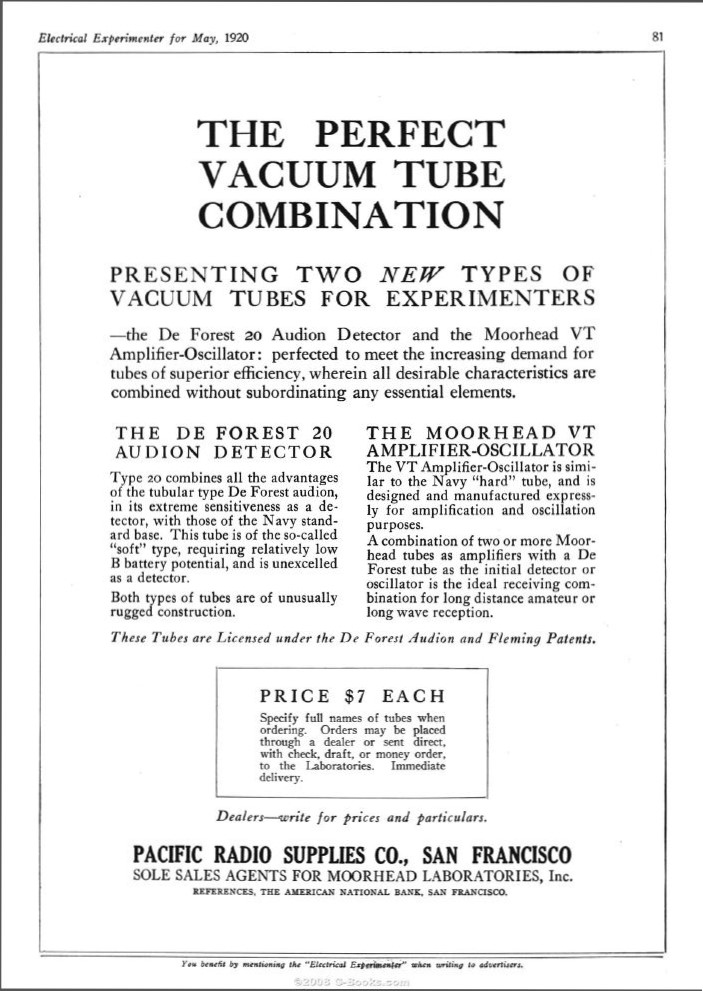
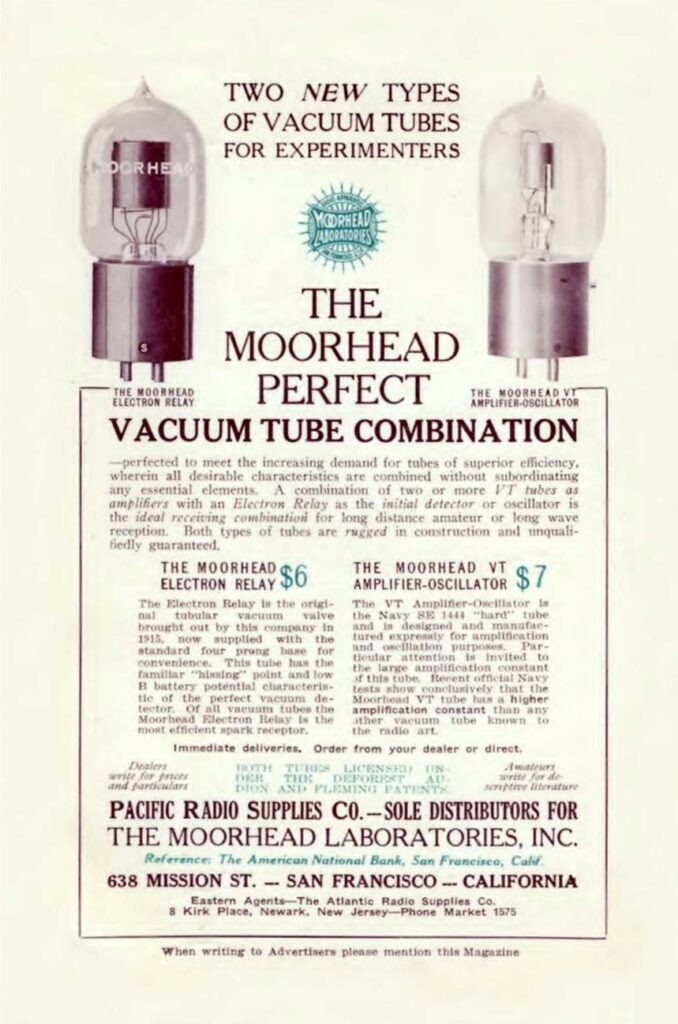
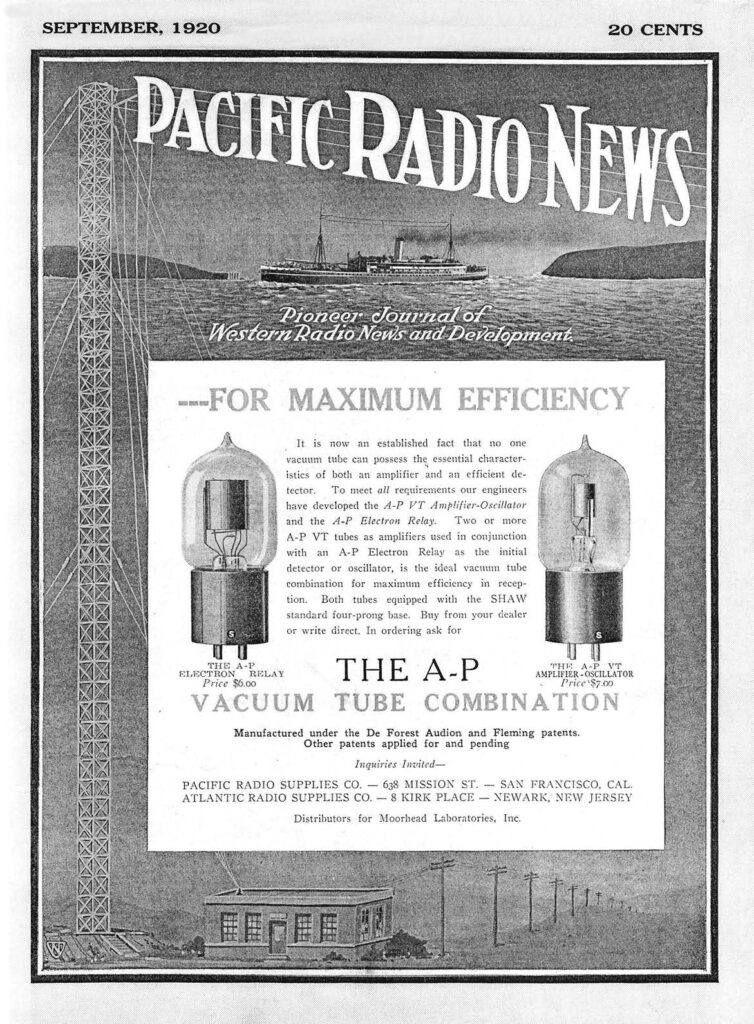
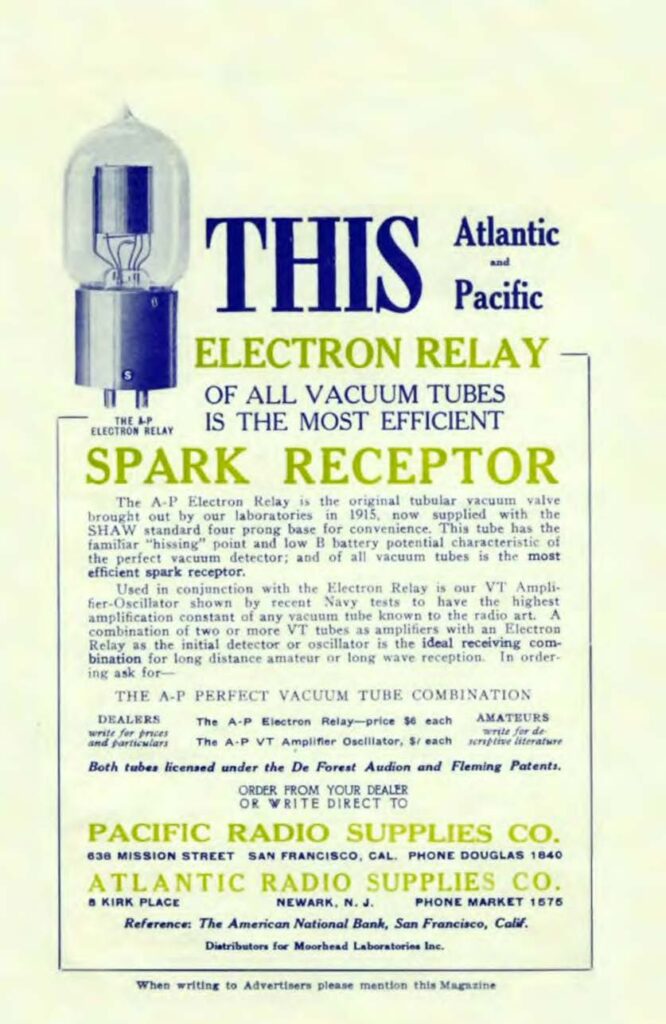
Fig. 50. This is the ad Moorhead placed for the DeForest type 20, shown in fig. 46 and type VT. In order, as the ad states, to be a perfect combination, the type 20 must have been intended to be a soft tube because the VT is a hard tube. Some collectors think the type 20 was the soft version of the DeForest VT-21. I have my doubts.
Fig. 51. Moorhead had his advertising dept. release the perfect combination of tubes, soft and hard tubes. The E.R. tube shown never really looked like the actual tube.
Fig. 52. Another ad for maximum efficiency combination. Shaw was in talks with Marconi and David Sarnoff about his infringing tubes and ads.
Fig. 53. A-P Electron Relay, Shaw claimed, was the best spark receptor. Thousands of amateur experimenters agreed. These ads were placed for at least 2 more years.



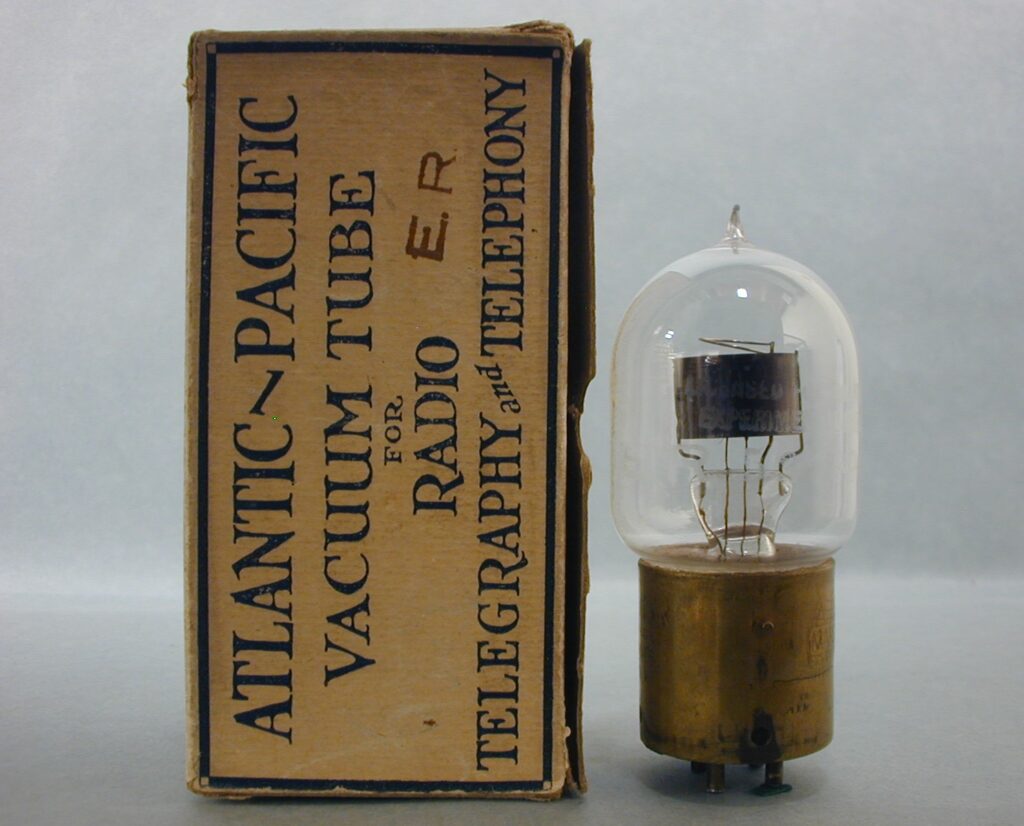
Fig. 54. This transmitting tube is a bit different that the type Special shown in fig. 38 in that it is more robust and more voltage can be applied. It has 11 turns of grid wire as opposed to 22 turns in the Special. Contrary to what I have owned in the past and have seen in collections, it does not have TT on the press but it is etched on the bulb. The earliest ad for this transmitting tube was noticed in the Dec., 1920 edition of the Pacific Radio news.
Fig. 55. Thiis tube is the A-P rectifier. Shaw claimed that DeForest forced him into selling his A-P Rectifier tube shown in the May, 1921 Pacific Radio News. He further claimed that he informed Marconi and RCA as this would have been a violation of contract, and only made them for a short time, after which, he dismantled the equipment and trashed it. From the number of surviving examples, this is probably true. My tube, oddly, has no serial number or pressings on the base indicating it may have been the first few made and released quickly? Tyne mentions that the DeForest A-P rectifier is a version of the Singer tube. They only slightly resemble each other with a quick glance.
Fig. 56. Shown is the soft Electron Relay. The materials to make the type of plate in the Electron Relay tubes in figures 47, 48, and 49 may have been hard to find. Perhaps a new way to rid the plate of impurities by heating the internal elements was used but now the plate is a dull darker color commonly called the short dull plate. The Marconi/DeForest logos are pressed into the bases on many of this type. This tube does not have an etched serial number so this was a way for Shaw to hide the fact that he was selling many more tubes that any contracts with Marconi or RCA called for.
Fig. 57. The shipping boxes for the Electron Relay varied as to what was available at the time as shown in fig. 57 like that shown in fig. 47. Again, the Marconi/DeForest logos are present with the serial number 537899 that conforms to those observed in fig. 15.
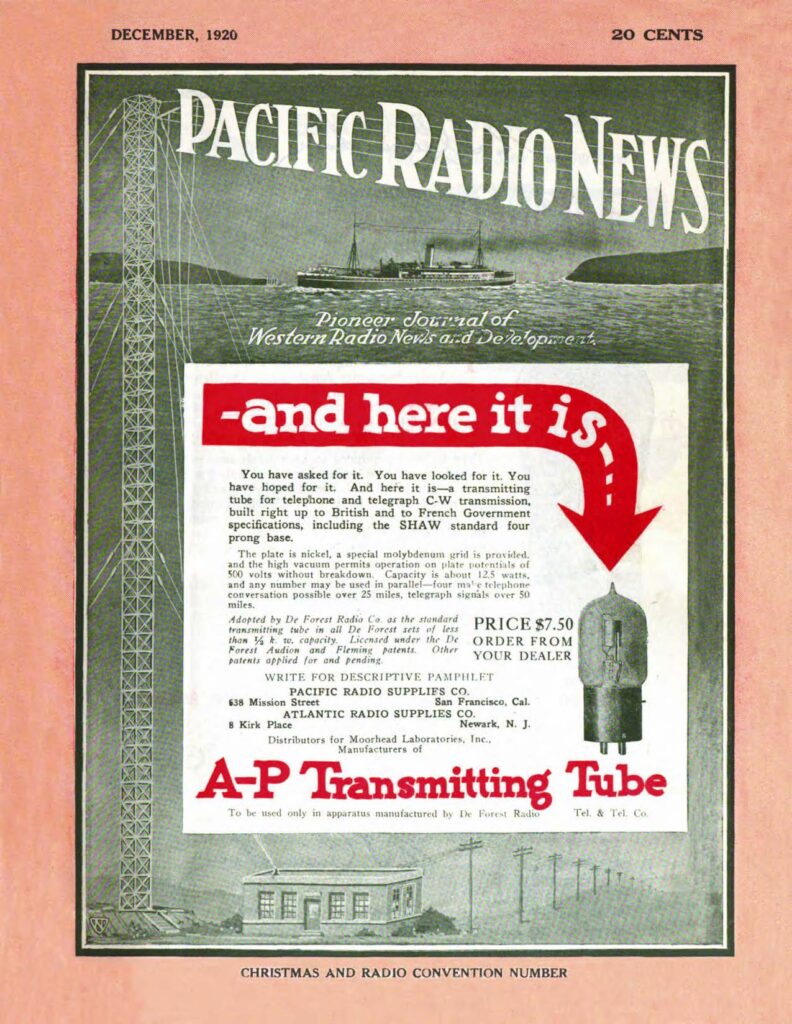
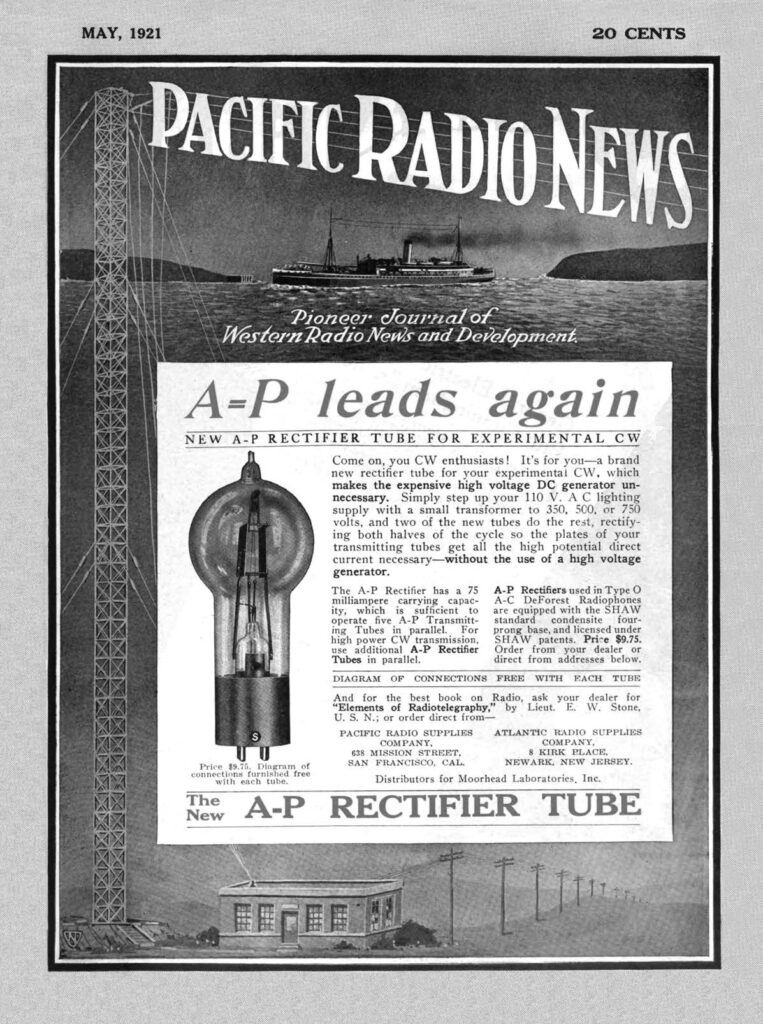
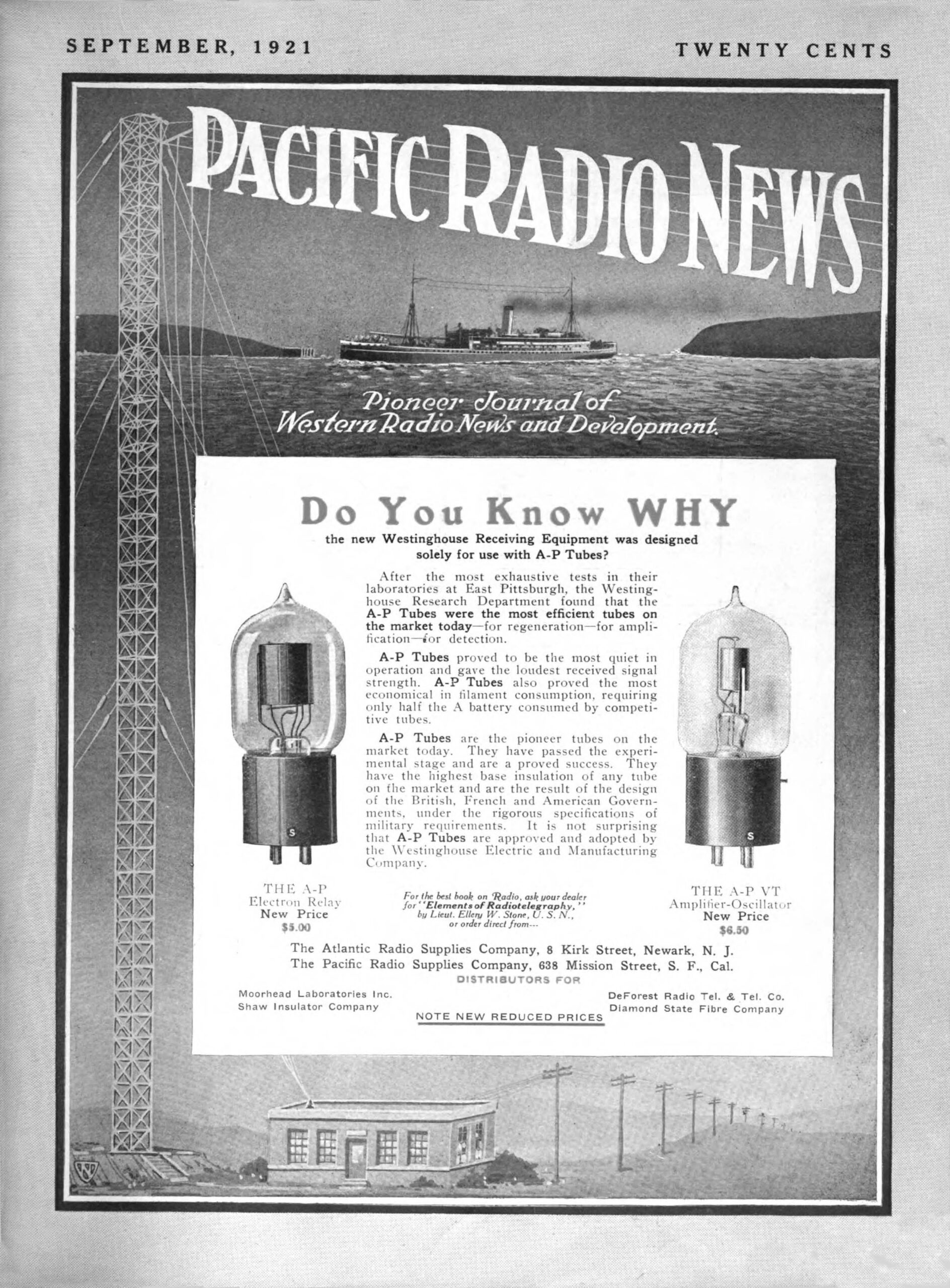
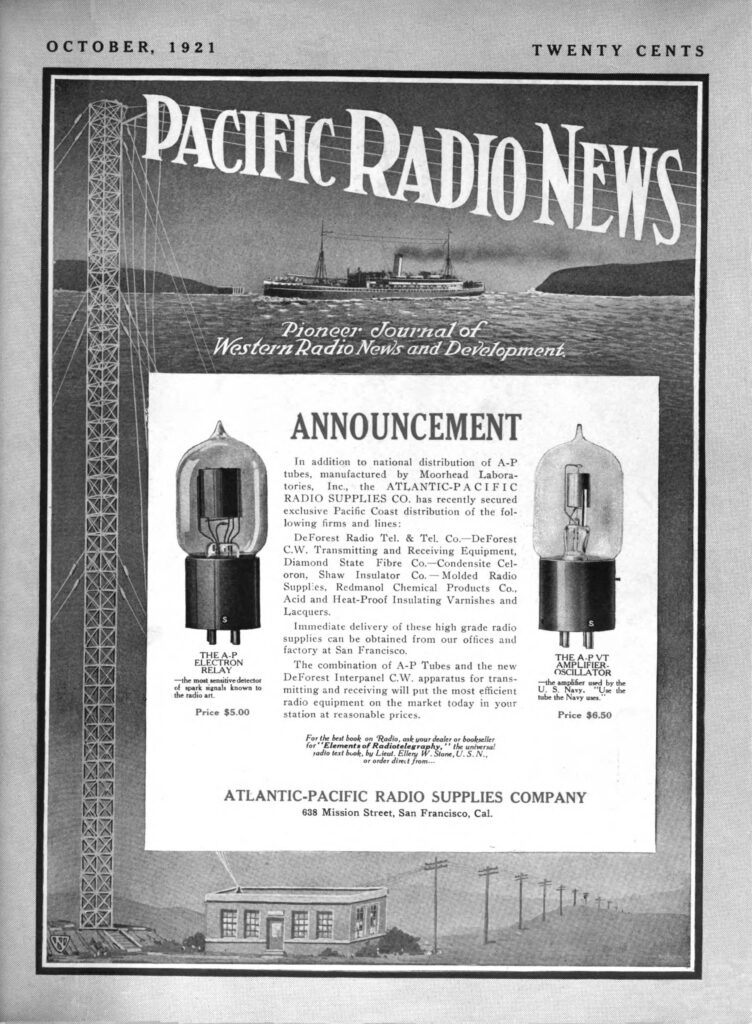
Fig. 58. This is the first A-P ad this author is aware of that mentions the new transmitting tube marked on the press TT not shown in fig. 54. It may have been made and sold previously marked as TT. but now it is official as of Dec., 1920. It was asked for and well received by amateurs, the ad states and it was probably more than true.
As contract talks between Shaw, Marconi, and RCA continued, 1920 ended. Shaw sold as many tubes as possible. In June, 1921 and the contract was still unsigned, Shaw and Sarnoff had a meeting to discuss, in RTCA’s mind that Shaw had already sold the agreed upon 35,000 tubes they agreed on. Shaw stated that this was not the case and had not even sold 10,000 tubes at this point, and further, he still had to make 35,000 tubes to catch up. It was obvious that Shaw was several steps ahead of Sarnoff and was selling more tubes than stated, and besides that, the contract had not been signed yet as per their initial agreement and Shaw could not be responsible considering that fact. Shaw was quite good at delay tactics while he made and sold hundreds, perhaps thousands of tubes. Several contract wording mistakes by RCA’s lawyers led them to now overlook any breech of agreements up to this point. Sarnoff warned Shaw not to announce any possible contract signing but Shaw ignored it and placed a statement that can be read here: M_D_2 Negotiations were a difficult problem for RCA as they needed to approve this contract with AT&T, GE, and Elmer Cunningham. These delays allowed Shaw to continue selling tubes and informing Marconi and RCA that they were holding up the signing, not him. The contract was finally signed in July, 1921. [2}
Fig. 59. It’s clear the tube shown in the ad is actually the DeForest Singer triode rather than the A-P rectifier in fig.55. It seems DeForest wanted the A-P rectifier to be placed in ad’s before the tube was actually made and could be shown? Some confusion is obvious. The second paragraph left states the tube is to be used for type 0 AC radiophones and a Shaw condensite 4 prong bases.
Fig. 60. The ad’s continued along with the sales, perhaps in great numbers. This ad states that Westinghouse found these A-P types of tubes were the most efficient made.
Fig. 61. Besides the contract signing in mid- 1921, Shaw announced a change in the company’s name. Now the name would be Atlantic-Pacific Radio Supplies company to replace two separate names, ie, Pacific Radio Supplies Company and Atlantic Radio Supplies Company and partnerships with various suppliers. Knowing Shaw, he had a very good reason for doing so and incorporated in the State of California. if for no other reason than to confuse the situation.
One of the terms of the contract stated Shaw was to give updates as to his sales numbers. Shaw sent a letter to RCA in early 1922 along with a royalty check for over $6,000 dollars. With their spy system still in place and with the help of Elmer Cunningham, a private investigator and an actual employee working in the factory, RCA had enough evidence to bring suit against Moorhead, Shaw and all companies involved. They did so under infringement of the Fleming patent in April, 1922. AT&T followed and brought suit a few weeks later. The letter was sent and received by Willard Williamson, lawyer for A-P and Moorhead Labs. Williamson wrote a responding letter saying Shaw was removed as president, this was the first he had heard of the sales contract with Marconi and Willis Demming was elected the new president. Its difficult to believe Shaw acted alone. The final legal outcome is obvious but the factory shut down, all employees fired. RCA and AT&T did try to recover royalties for the estimated 150 to 200 thousand tubes sold by Shaw and all. [2]
In mid 1922, Williamson, in trying to recover, asked Sarnoff to extend the Fleming and DeForest patents in the form of a license. Sarnoff refused. He then tried to sell the whole lot, but no one was interested. He changed the focus and sell anything other than vacuum tubes. A man named Paul Oard made radio’s and used A-P to sell. Stock was sold to raise capital. This endeavour continued until Dec., 1922 after which ads disappeared. This seems to be the end of A-P Radio Supplies Co. but they have another idea that could make some money yet? [2]
On Nov., 1922, Otis Moorhead, sought to start a new company, Universal Radio Improvement Company. This may presume that he had an idea for a tube that would not infringe the DeForest patents. It can only be speculation as to what that tube would be? In Feb., 1923, Moorhead died as a result of an operation he sustained after an injury, No one will know which tube he had in mind, his original un-based E.R., the A-P Solenoid, or the A-P Two one. [2]




Fig. 62. The prototype tube shown is the most unusual A-P solenoid designed by Henry Huppert. Huppert had been a consultant for Moorhead back in 1917. The design was an external grid tube that would not infringe the DeForest patent. As can be seen, the grid is spiral wound and would work by producing a magnetic field inside near the filament and flow up to the plate on top, flowing from the middle to the outer structure in circle and flowing again up through the lower center. The old Moorhead machines had been left in place, awaiting the expiration of the DeForest patents and Huppert was given permission to use them, in 1923. With these machines, along with Huppert’s own machines he used in his X-Ray labs began to produce the solenoid tubes. These events did not escape the watchful eyes of Cunningham and RCA and reports were sent to Sarnoff. Much design work had to be performed to perfect, as much as possible, a useful vacuum tube. Here is the patent application Huppert applied for here: pat Huppert also drew an explanation of how he thought the Solenoid would work and presented it to his attorney here: DO3
Fig. 63. William Hanscomb was an engineer and consultant for A-P, designed and tested a series of 40 solenoid tubes and kept a notebook with the results. The solenoid tube shown in fig. 63 was number 5 as can be seen on the paper tag dated 5-27-23. I received a scan of a few pages of the original notebook that were trans-scribed. In reading the Hanscomb note book, it was found that the solenoid was a poor amplifier but a very good, distortion free detector. When pressed, Hanscomb could not explain why the tube worked at all. Notice in the last part of the Hanscomb note book in which he states he is looking into another promising tube- the A-P Two-In-One. It seems that A-P did not have the will or money to release the solenoid tube in 1923 but a new company was going to emerge that would. 4 pages from Hanscomb’s notebook can be seen below.
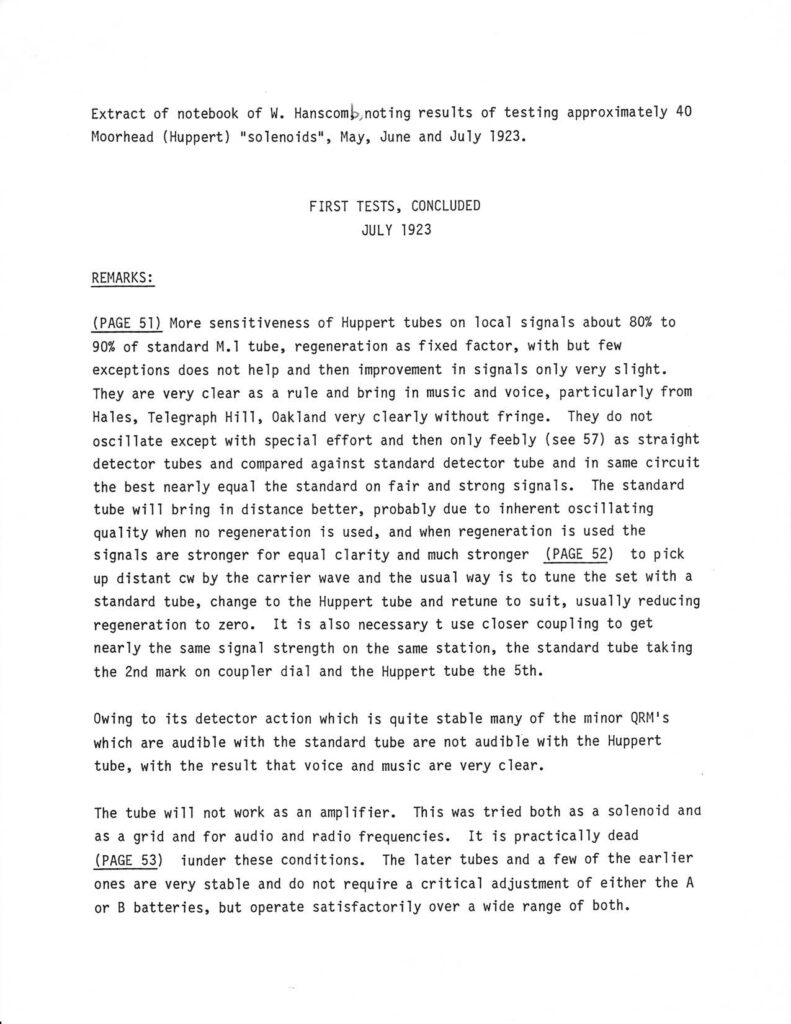
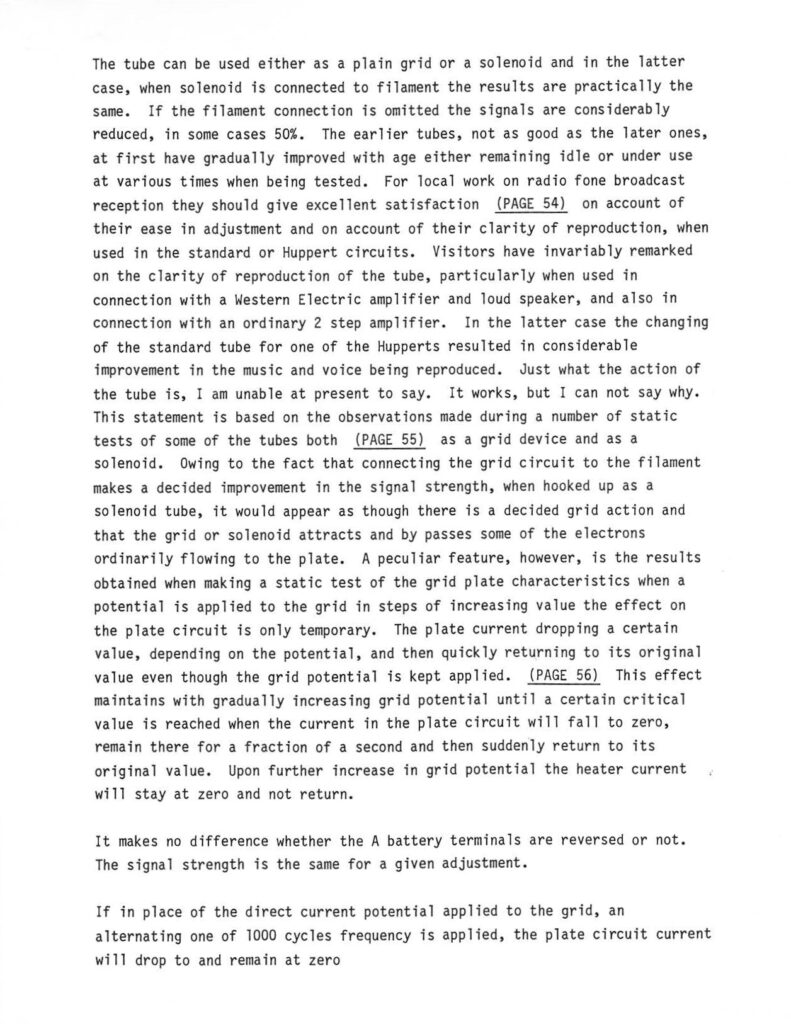
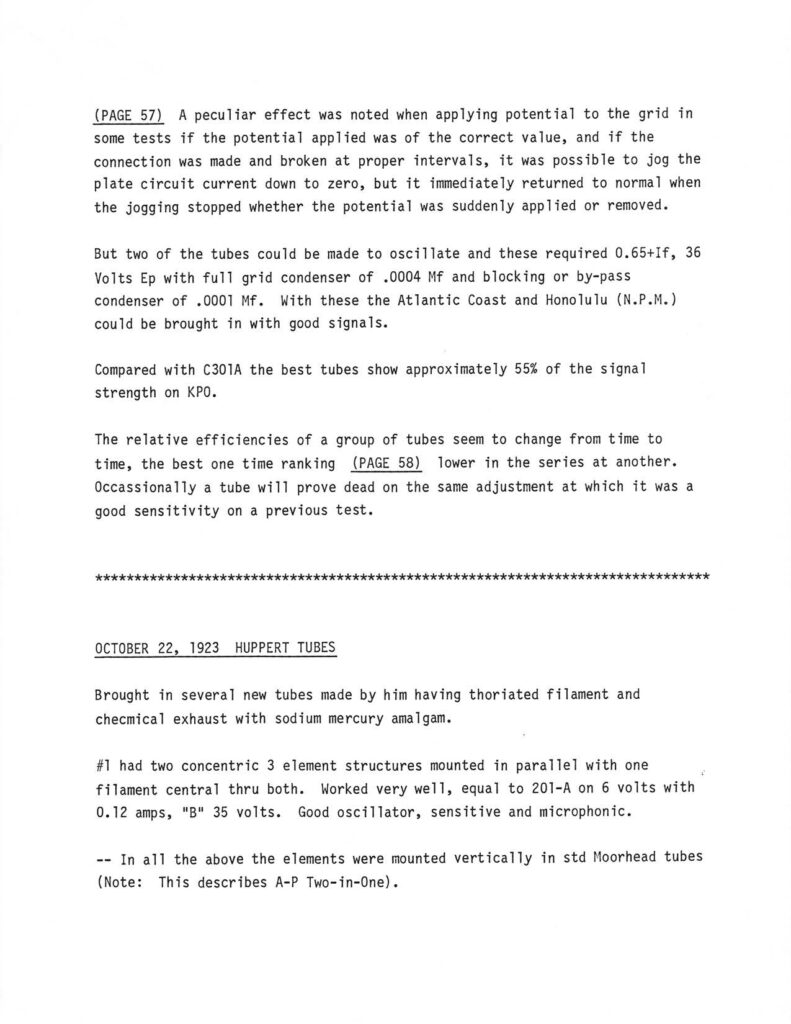
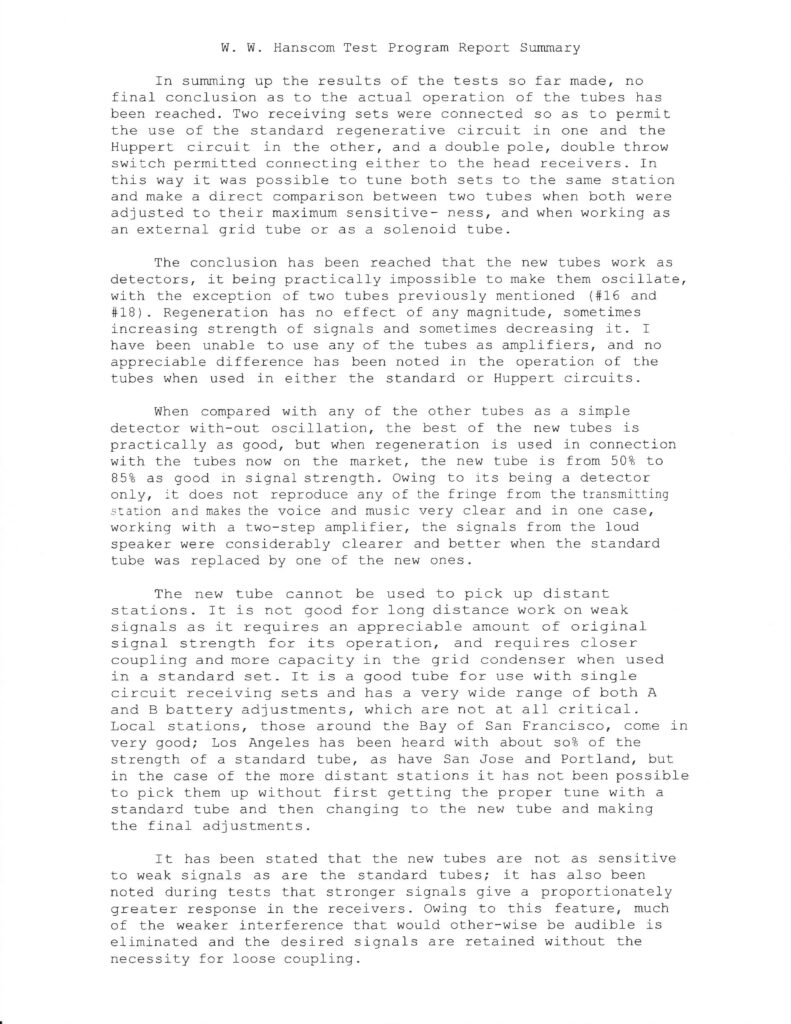
Fig. 64. Despite being, generally, a disappointment to A-P, they did market and sell the solenoid’s commercially to the estimate of around 1500. They used the left over E.R. tube boxes but included in each box very specific hook-up instructions. Fig. 64 shows one of the tubes sold with the serial number 1380 and the words A-P Solenoid and patents pending etched on the glass bulb. Please notice the grids diameter size between the prototype and the finished product. In each Solenoid box, hook-up instructions were included shown here: sole
Fig. 65. Here is a second solenoid tube, etched 1389 and patent legend and same box with the hook-up directions inside. The box on the right in fig. 65 is a bit different than the original E.R. boxes as the Fleming patent info has been removed but because A-P was hoping DeForest would allow A-P to use his patent rights, his patent numbers were printed on the box, but, that possibility did not happen so they just put a patch over it. Please read again the great history told by Frank Polkinghorn to Jane Morgan called FP_P in fig. 11 above.
In Jan., 1924, Williamson decided to left the charter of Moorhead Labs to expire along with the A-P Radio Supplies Co. mostly because the Oard radio sales were not going well, despite the fact they had inventory of the solenoid and a promising new tube, the A-P two-in -One tube. Williamson had previously filed for a name change to the company in May 1923 to Atlantic-Pacific Sales Company. Here is one of the few ads mentioning A-P Sales Co. here: CAP_6 Yet another company was formed now called the Atlantic-Pacific Agencies Corporation apparently changed for legal reasons so as to rid themselves of the legal burdens of the previous companies, Any association with Moorhead Labs and it’s sales agencies were now gone and all that was left was Moorhead’s original manufacturing equipment in storage. The already made solenoid tubes and the future Two in One tubes would be sold under another company. [2]
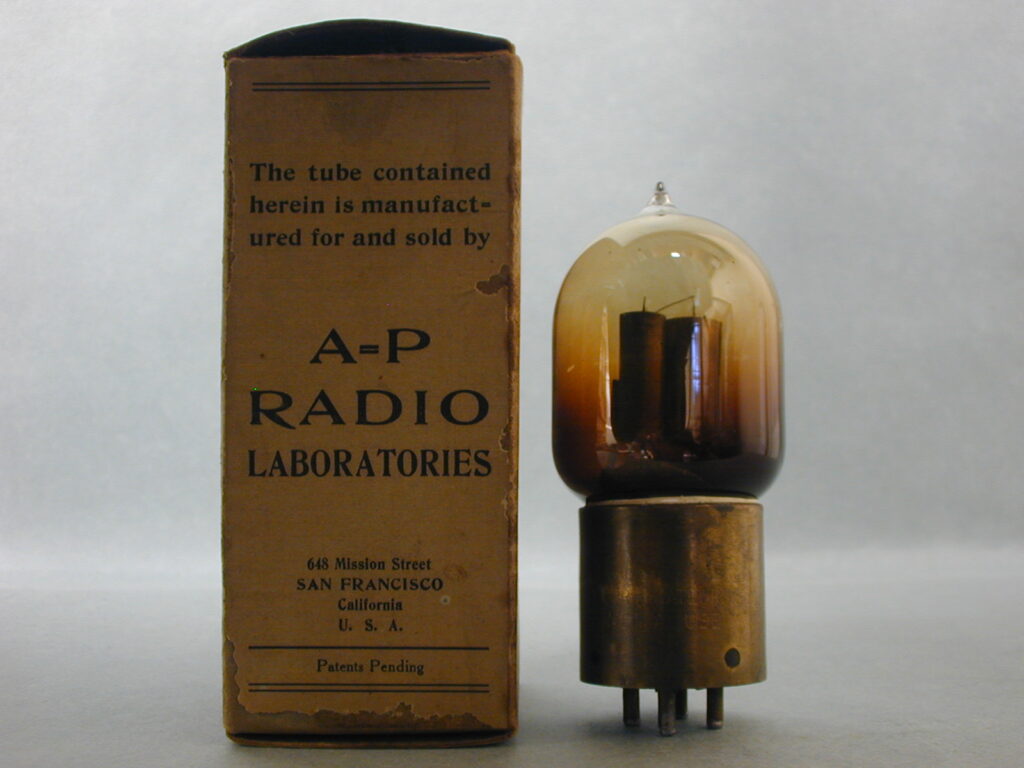


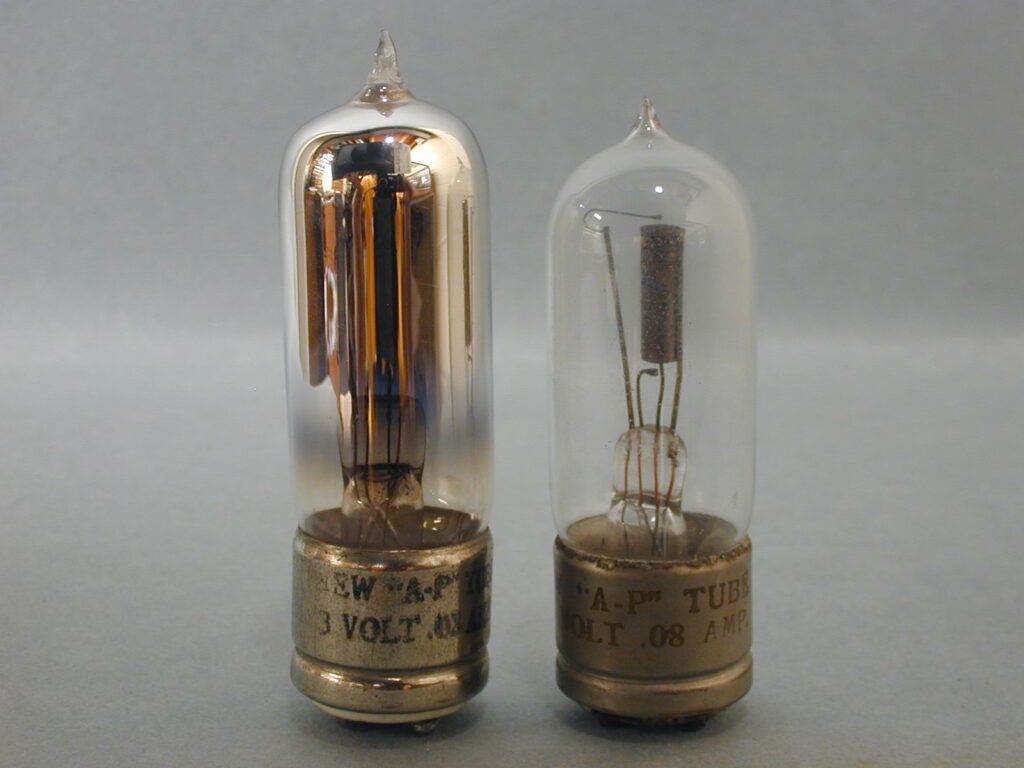
Fig. 70. In 1925, a last ditch effort, a final company name change to A-P Radio Laboratories Company would allow this group to make the Two in One tubes, distributing said tubes and finally selling of the remaining equipment. The name change can be seen on the shipping box in fig. 70. They used remaining boxes from the E.R. era and just pasted on printed paper that stated what was necessary and in a few had new boxes printed. The tube name states exactly what it is, Two triodes in one structure. The particular tube in fig. 70 is believed to be an experimental Two in One in which they used phosphorus getter and eventually settled on magnesium used in the remainder. They also used the remaining stock of Shaw Bases with the Marconi/DeForest logos partially ground off with enough left to determine this. This is the only experimental tube of this type the author has seen. The Shaw base on this tube also has a hole in the bottom were the second leg of the half the triode filament is brought out thereby allowing the tube to burn both filaments at the same time. if the owner wanted. This in effect created a fifth connection on the tube. By this time Henry Huppert was a key employee and head of manufacturing, not to mention the designer of the Two in One tube. His patent can be seen here: pat2
Fig. 71. Another side the box here has the new A-P Two in One wording pasted on with a separate paper on to the old box. The tube again, has the Shaw base and the second filament wire sticking out the base to be connected and then burning both filaments at once. The wording in ink on the nickel base states Two in One A-P tube, made by A-P Radio Laboratories, San Francisco, patents pending. This tube is identified as the 625D detector tube in the A-P advertising that will be shown. Hook up instructions were included in every Two in One box and can be viewed here: AP_O
Fig. 72. A new shipping box has been designed. Same inked wording on the tube but a new familiar porcelain disk is pressed in the hold the pins with the second leg of the filament now soldered onto that base. It is numbered in ink on the bottom 1481. This tube would be known as the 625A or amplifier in the advertising.
Fig. 73. These tubes have the familiar 199 pins in a porcelain base and has similar characteristics as a 199. They would be called the 306P in the advertising. The tube on the left would be the normal hard version and the tube on the right has lost it’s vacuum but allows the inner structure to be seen.
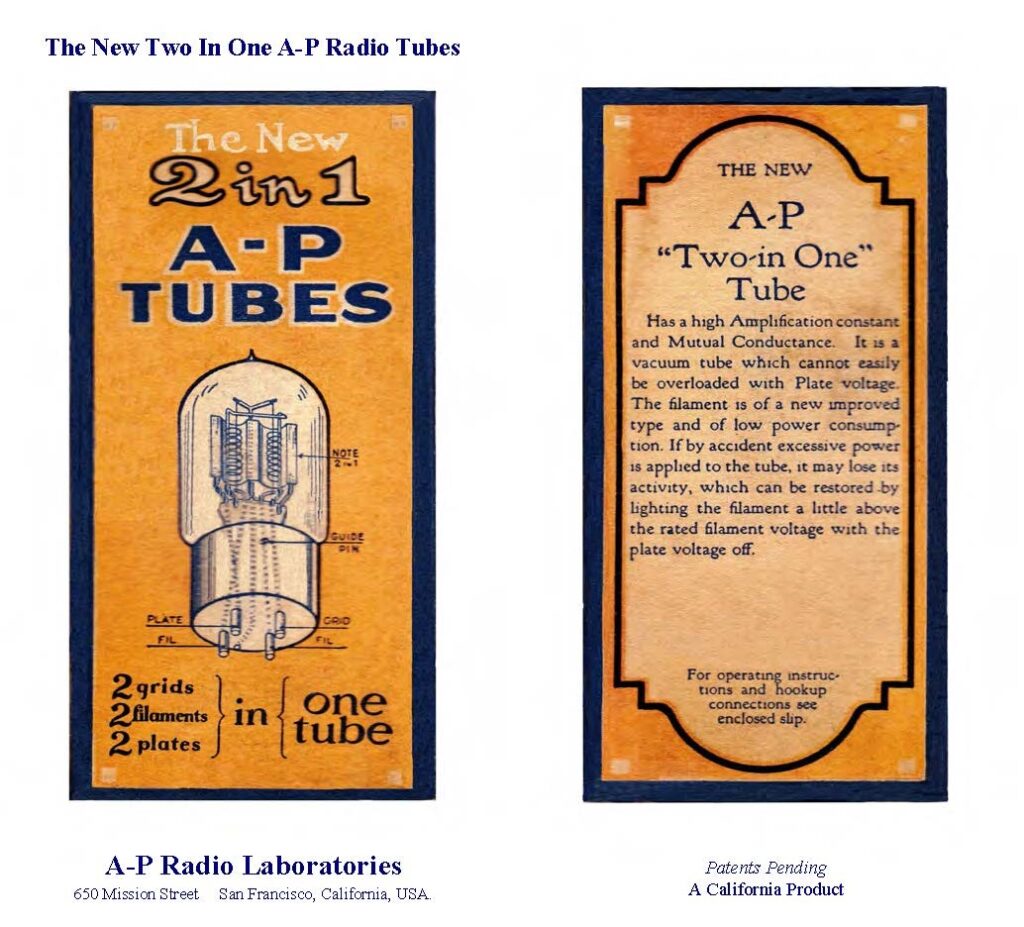
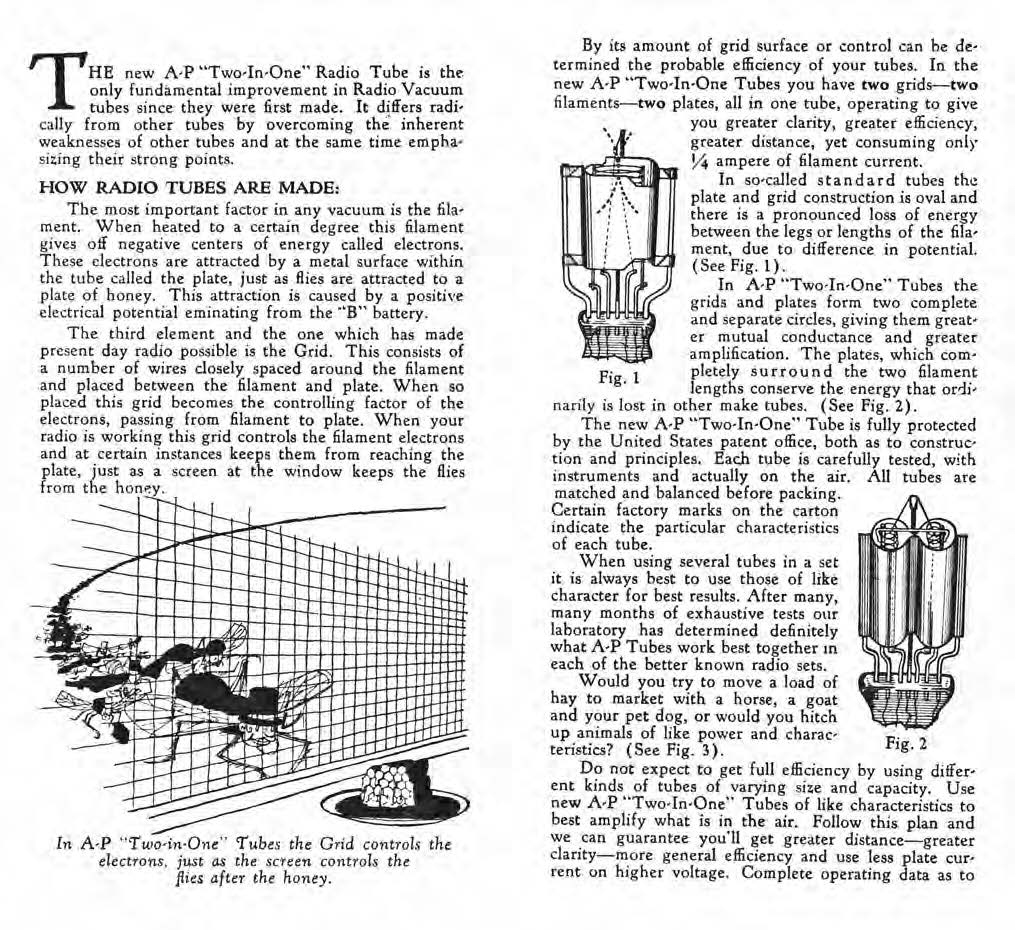
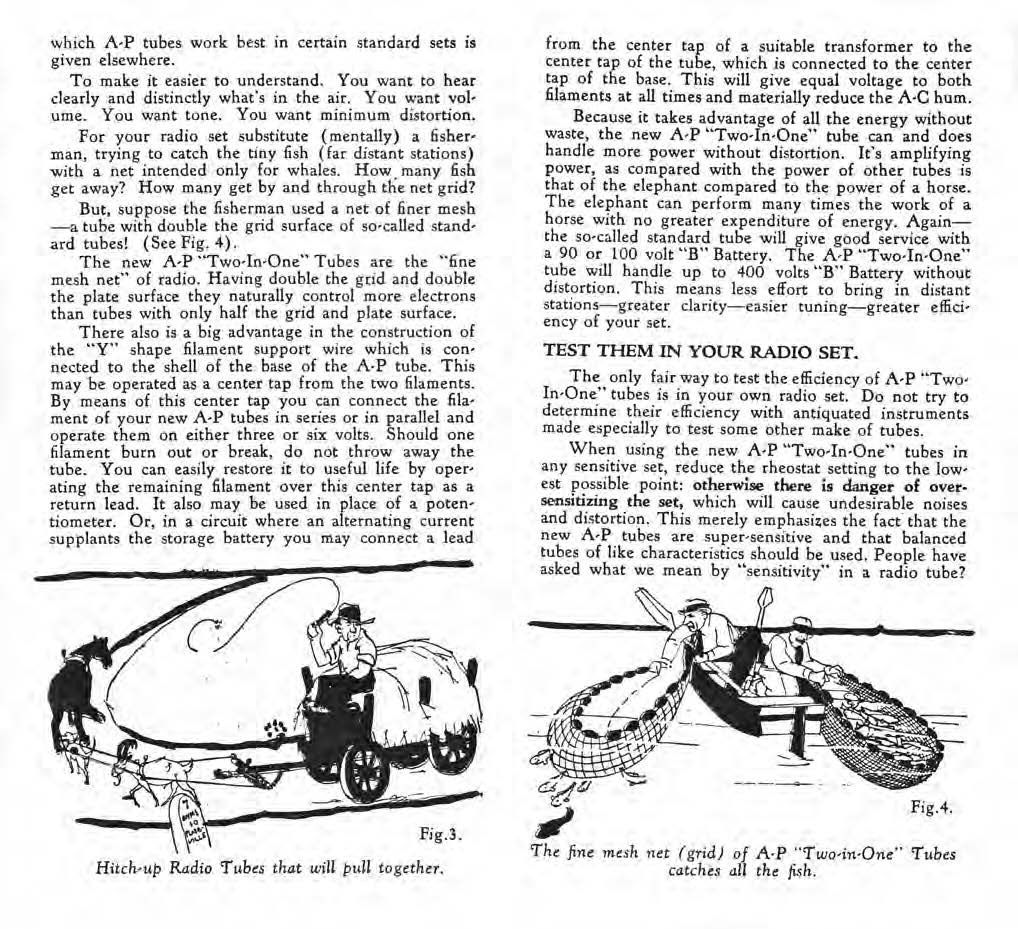
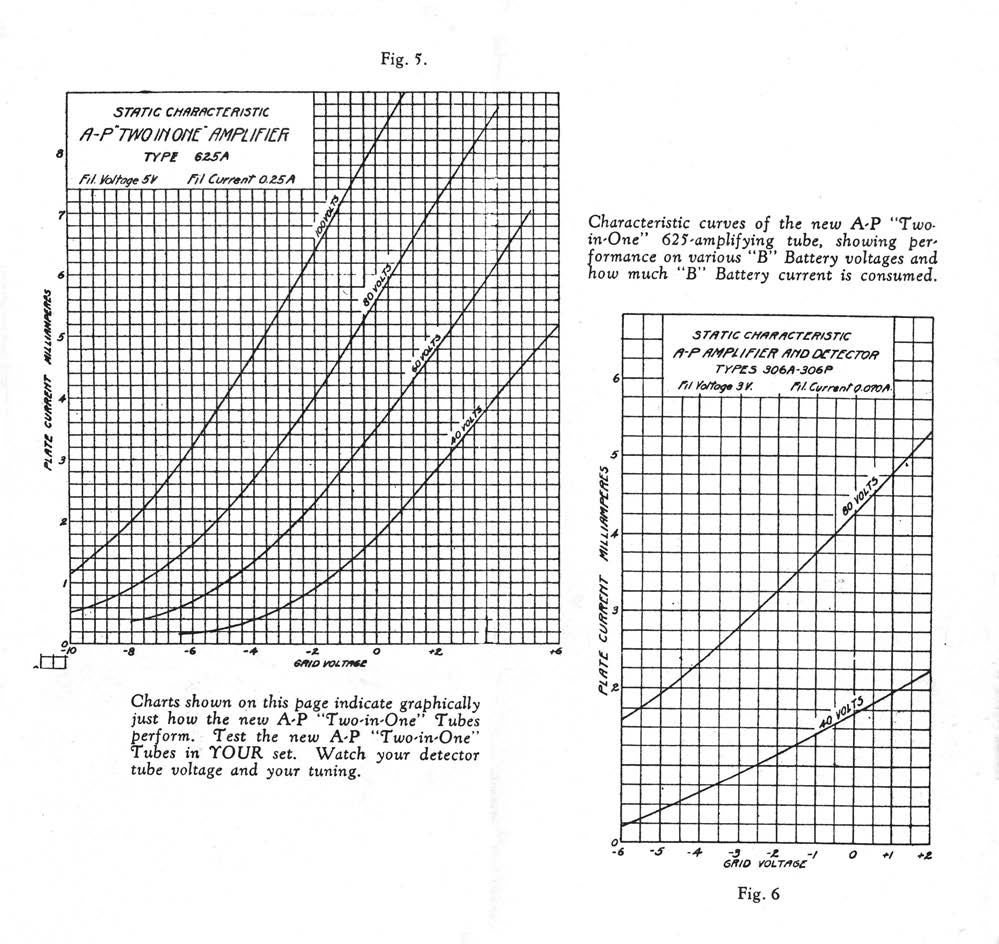
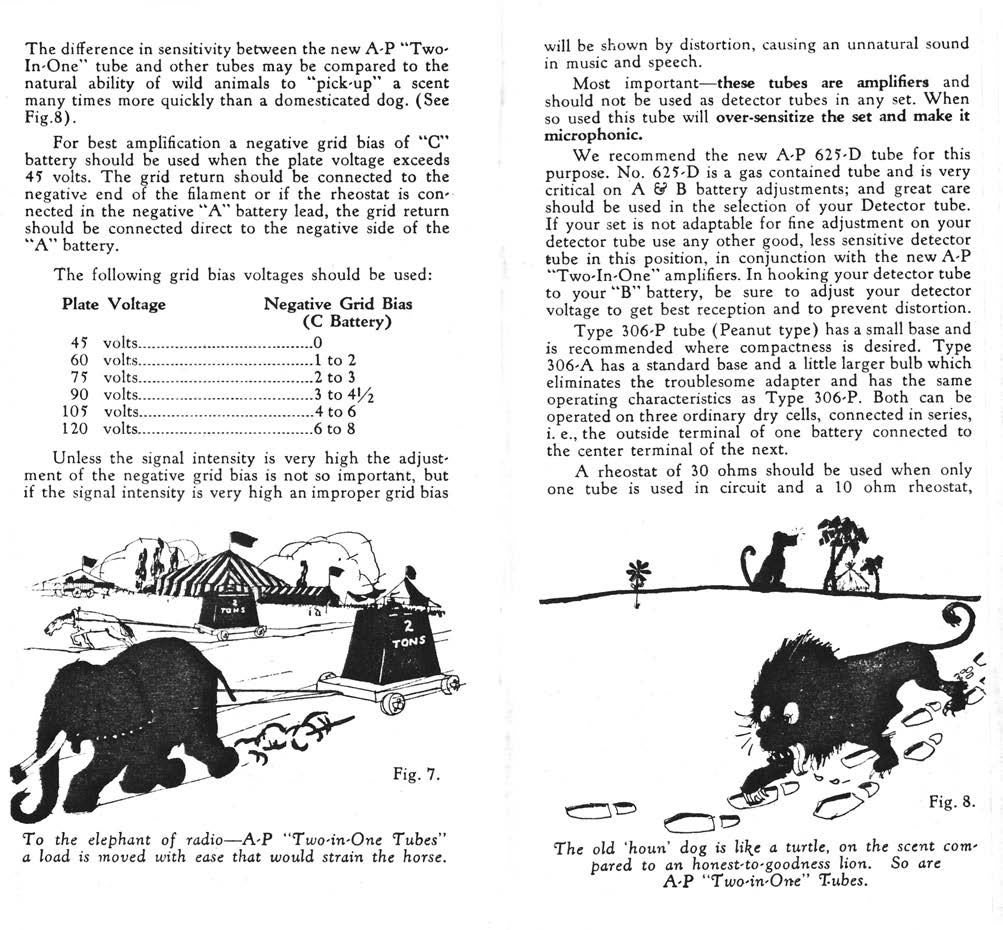
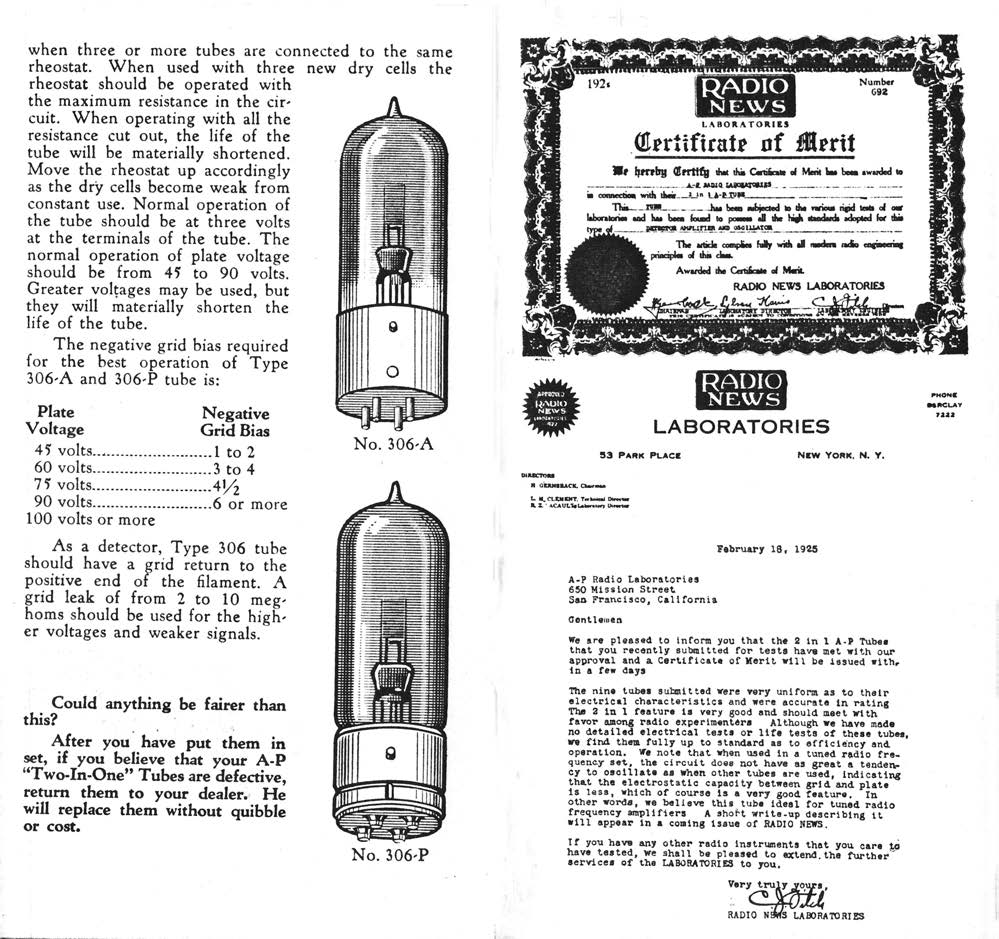
Figs. 74-79. Brochure A-P Radio Laboratories Co. made for their distributors.
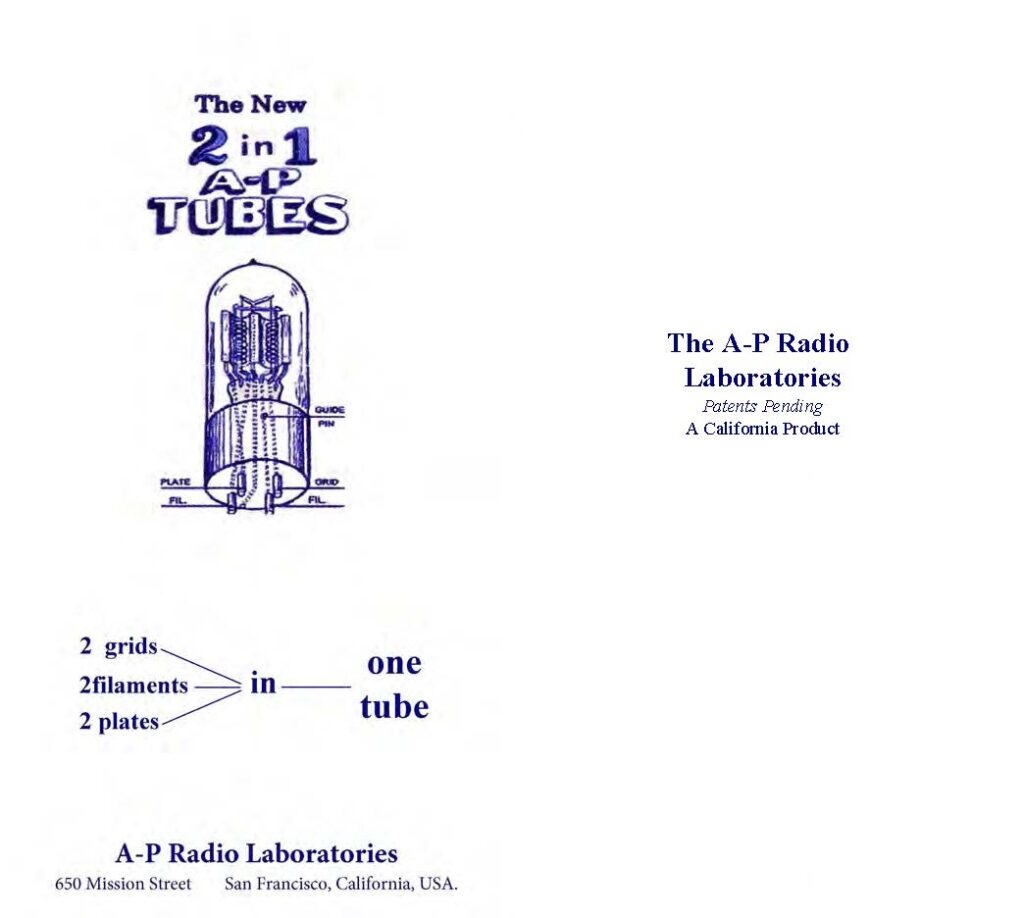
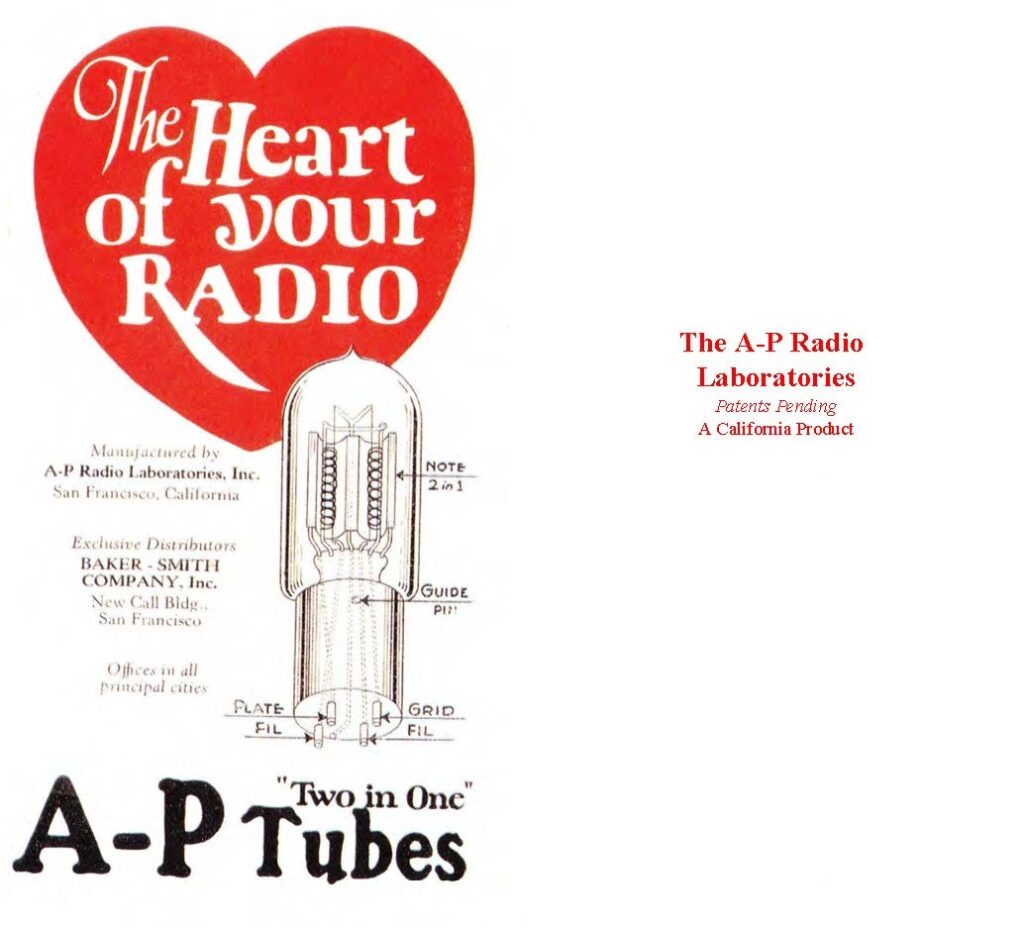
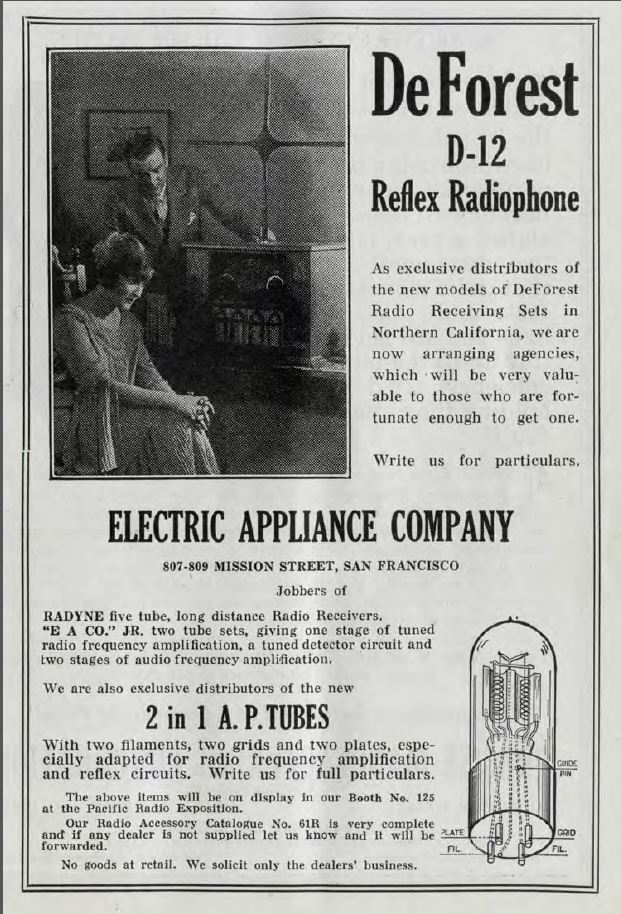
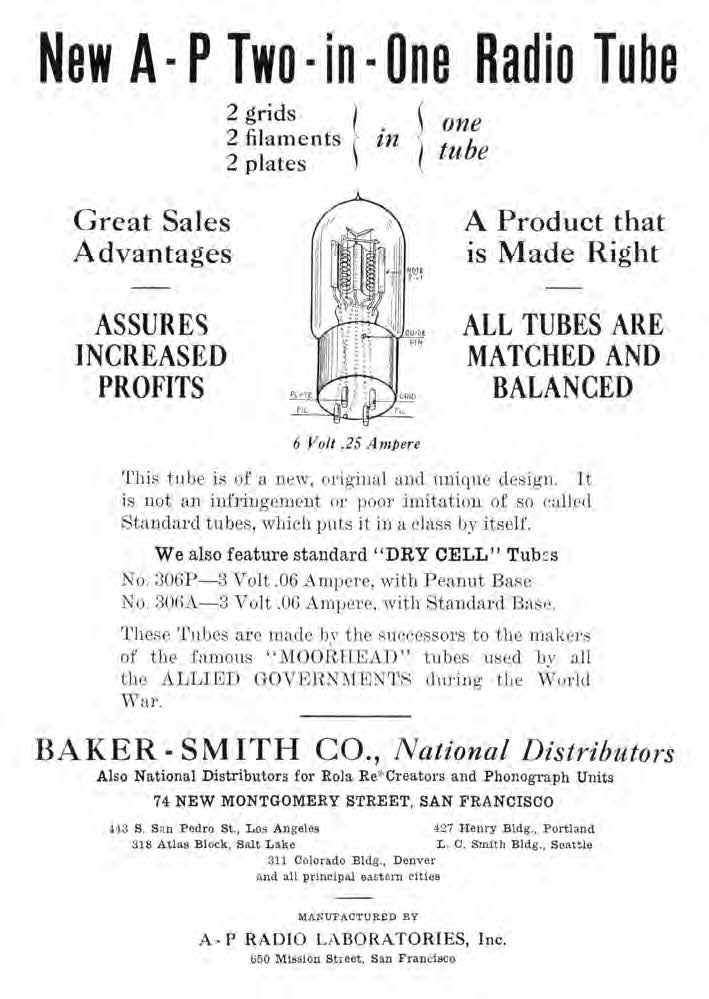
Fig. 80. This brochure has a different front and rear cover but the same contents as figs. 74-79.
Fig. 81. Yet another brochure with a different front and rear cover and same contents as 74-79.
Fig. 82. The Electric Appliance Company was the first to sell the Two in One tubes for A-P. They were located just up the street from A-P’s address at 650 Mission St.
Fig. 83. Baker- Smith was another seller for A-P.
A-P Radio Laboratories Company made about 40,000 tubes in total. How many were of the solenoid type or Two in One tube is not known. In July of 1925, A-P discontinued business entirely. First of all, their days were numbered as infringement law suits would soon arrive. Second- the price of vacuum tubes dropped to the point that they could not sell for a profit and third reason was difficulty in getting filament material. [2]
Shortly after A-P quite the business, QRS music bought the patent rights and all equipment. The new QRS Red Top vacuum tubes had the very same construction as the Two in One tubes, in other words, a double triode design. See one of their brochures here: QRS
In 1928, QRS Radio was absorbed by Raytheon. See the announcement here: QRS2
Footnotes:
- All tubes are in the authors collection
- [2]. Many, but not all, of the scans of original Moorhead documents courtesy of Will Jensby
- Much, but not all, of the facts and dates can from the of research of Eric Wenaas. I suggest his article called “Otis Moorhead and the Vacuum Tube Tangle” be read appearing in Vol., 27, 2014 AWA Review.
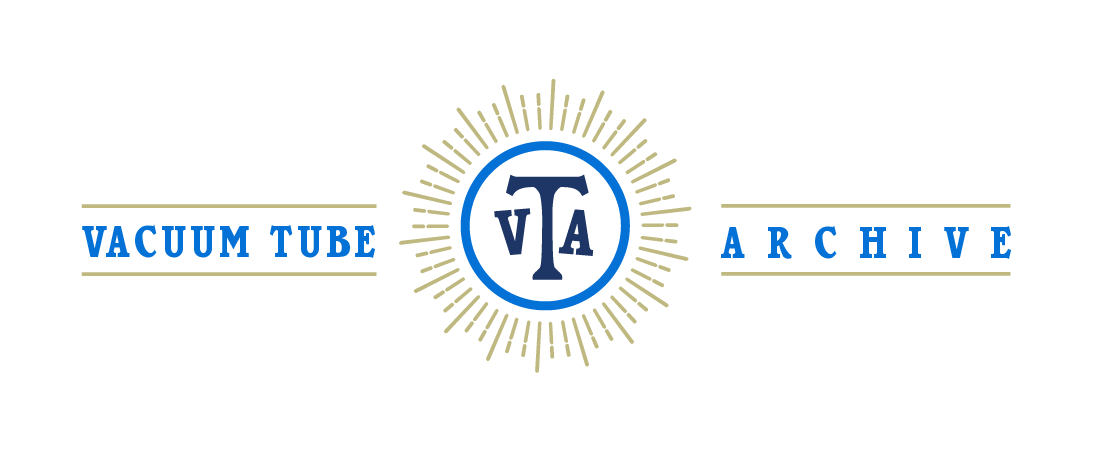
Leave a Reply